
220° panorama September 2011
This is my refuge from the pressures of others' expectations and the close quarters of urban living, a private place of peace and belonging for me and plants, insects and birds that share our world with us. The scale is that of a woodland glade, with views terminated by tall plants and vines on fences, with varied light and soil, and water for wildlife to drink and bathe in. Artificial elements take second place to natural ones. I'm not driven to excel here as I was for so much of my life, instead I'm able to be one with our mother earth. Nothing is a weed if it's yellow. I keep any plant here if I enjoy having it as company.
At one side is the sofa swing I grew up in, shaded from afternoon sun by a neighbour's cedar hedge. At the other, shaded in the morning, is the picnic table from the Cumberland homestead where so much of my heart was left. Ribes aureum provides food for chipmunks and robins, a small pond provides water for them, and a 12 m clump of Thuja occidentalis provides shelter for the birds who feed on black oil sunflower and niger seed in feeders hung from the house eaves. Seed-bearing plants are cut only in the spring to provide natural bird food over the winter. I've seen 42 species of birds find shelter, food or water here so far, as well as 12 wild animals and over 300 insects; I'm surrounded by young song sparrows most of the summer. One major thing is missing though: Batrachochytrium dendrobatidis has arrived in Ottawa and almost extirpated the toads that announced the arrival of spring throughout my childhood and in my backyard ponds until now. I've only seen one in all the time I've been here.
As with my Fletcher meadow trial of many years ago, I'm starting with many species and varieties of plants and expect them to settle themselves down to perhaps half the initial number. As a naturalist, my aim is to create good habitats, then let plants flourish that happily grow there.
Plants need light, water and nutrients. Since most of my area is short on light, I ensure a supply of the other two. Cocoa shells, neighbours' leaves and bonemeal provide a continual infusion of nutrients, a sprinkler system that is turned on during droughts ensures steady soil moisture in most areas.
Plants that have proven themselves here and that I can recommend to other Ottawa gardeners are in bold. Notes and photos will grow and disappear as the plants do.

| This forms the outside boundary - tall plants, shrubs and vines. | mouseover thumbnails for full images
human insect |
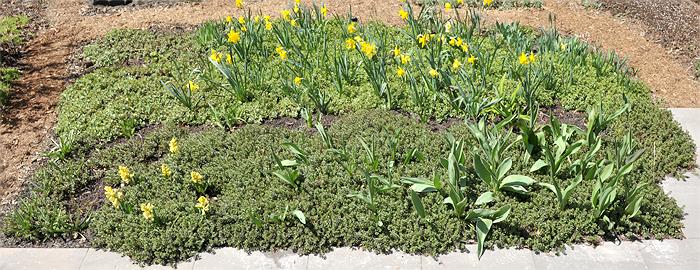
| This was built spring 2011 as a geophyte garden - bulbs, corms, tubers and rhizomes. | mouseover thumbnails for full images
human insect |
| Eremurus 'Moneymaker', with E.isabellinus as a parent, is the only E. that has survived here It's clearly marginal, frequently skipping flowering; 80% sun. |
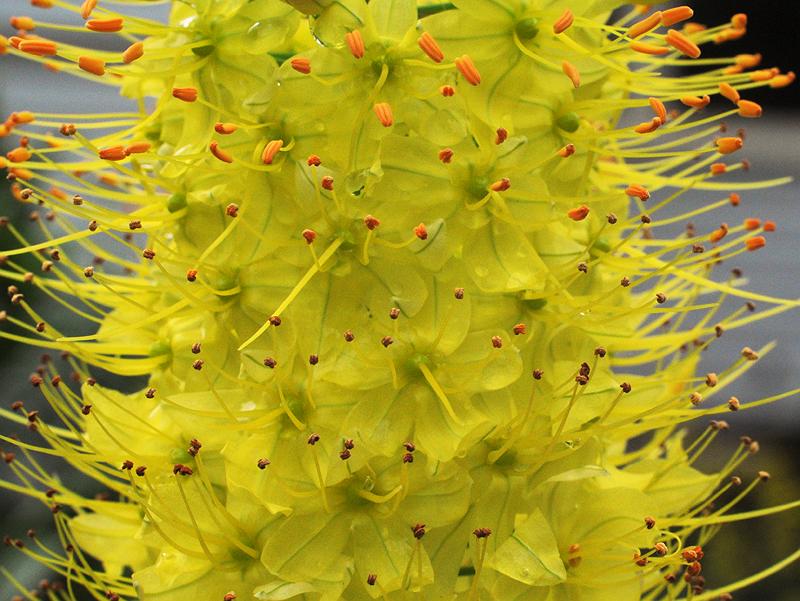

|
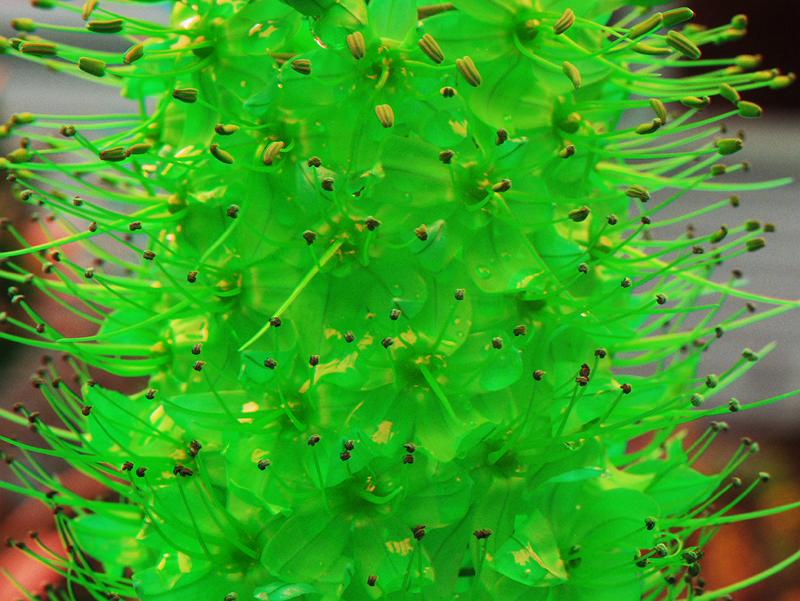

| |
| Hemerocallis species were used for food throughout Asia since time immemorial, but didn't appear in Europe until the 1500's. They are so easily grown and so variable that there are now over 50,000 named cultivars. A row was added summer & fall 2011 in 80% sun. From left to right: | |||
| Hemerocallis 'Andrew Christian' is a tetraploid with wonderful fragrance morning & evening; flower diameter 150 mm. |
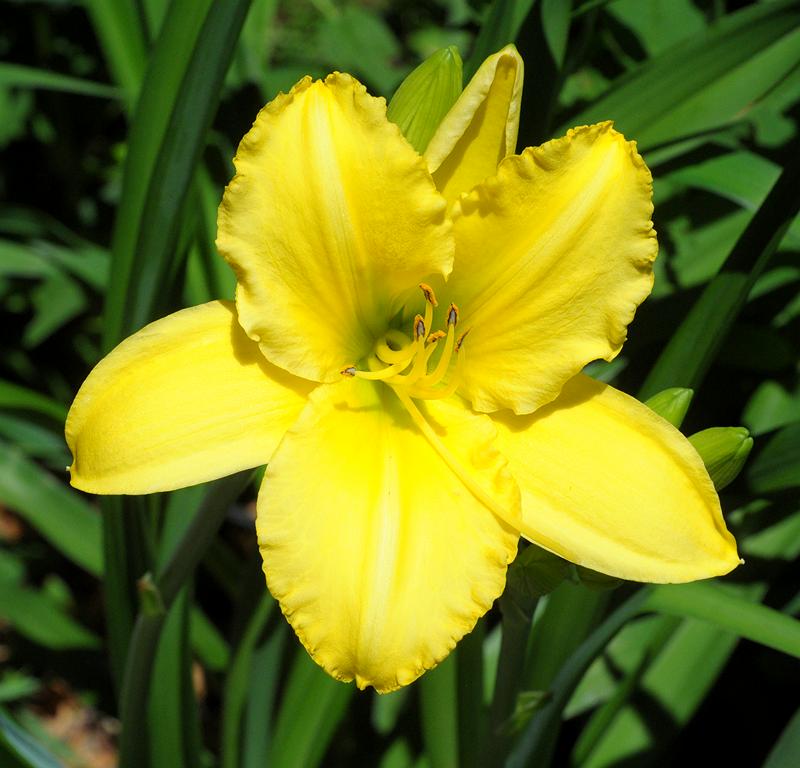

|
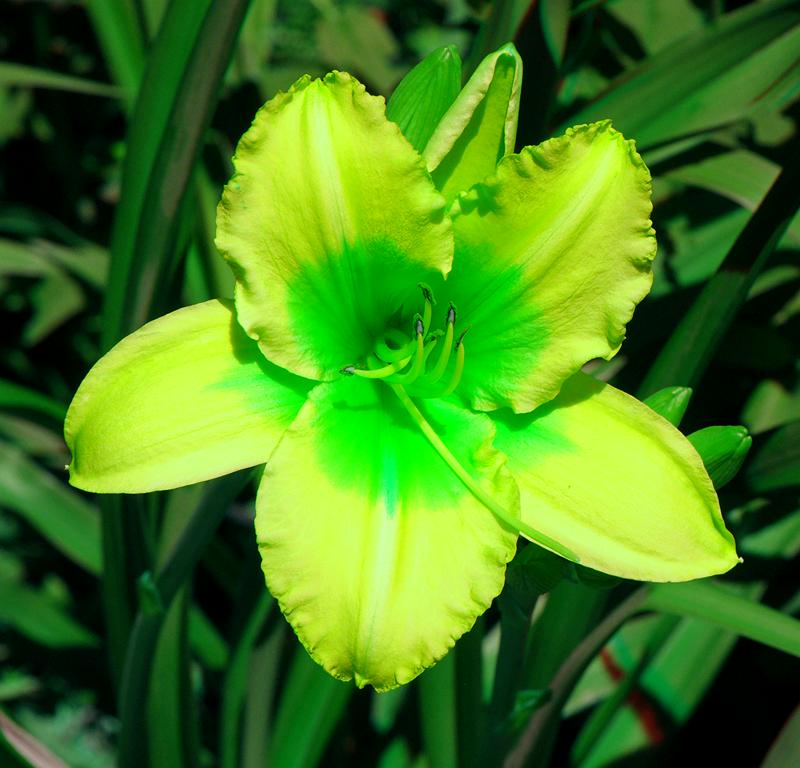

| |
| Hemerocallis 'Omomuki', also a tetraploid, has heavily ruffled petals; flower diameter 140 mm. |
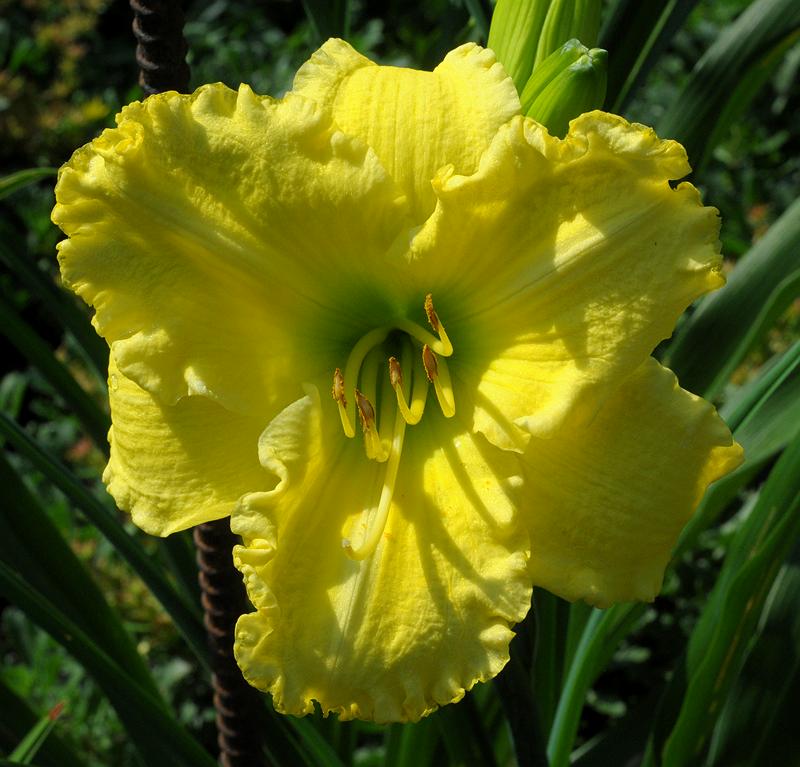

|
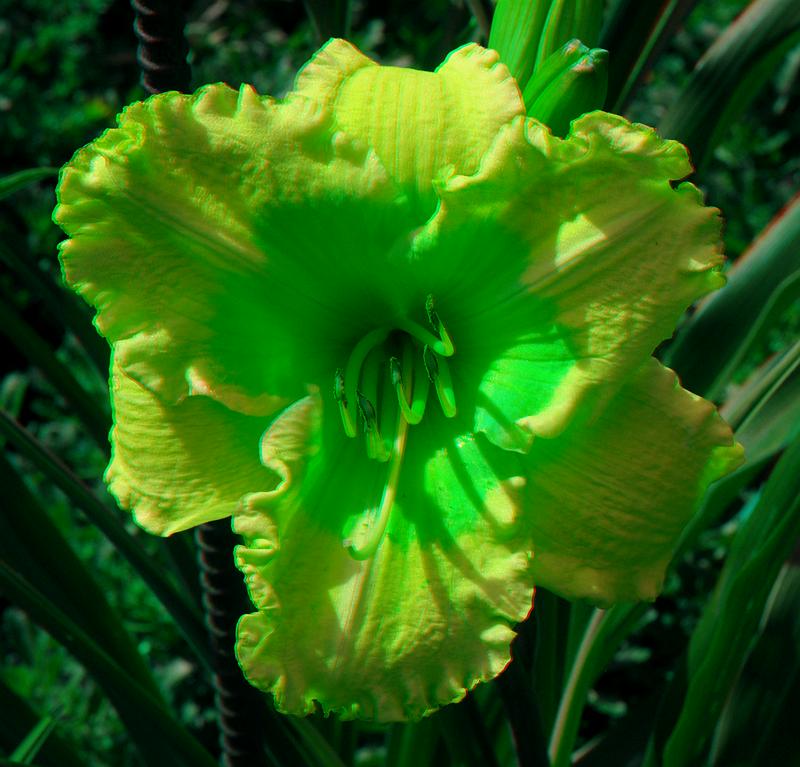

| |
| Hemerocallis 'Siloam Amazing Grace' is a vigorous diploid, loads of blooms with rolled petal ends; flower diameter 135 mm. |
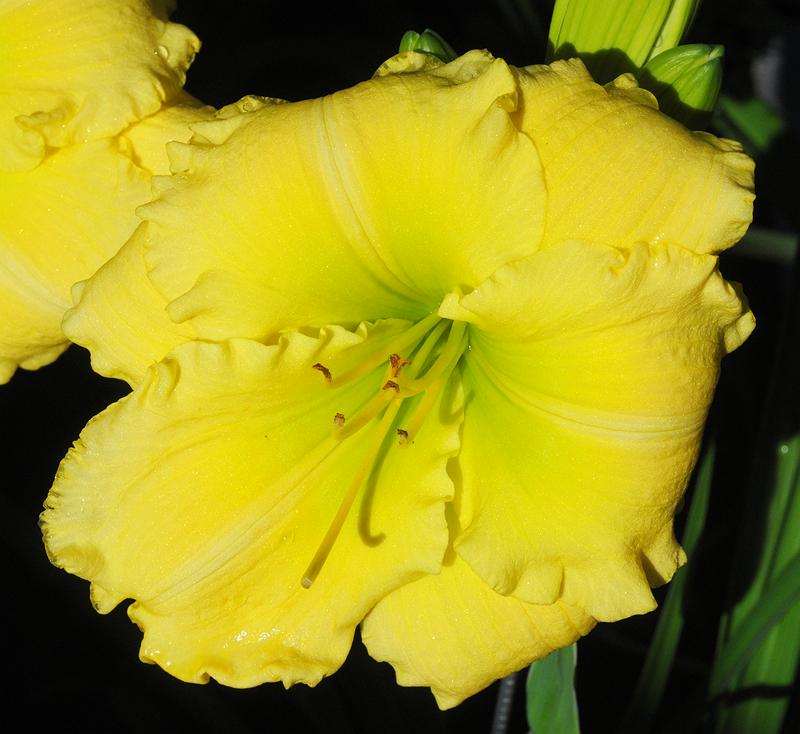

|
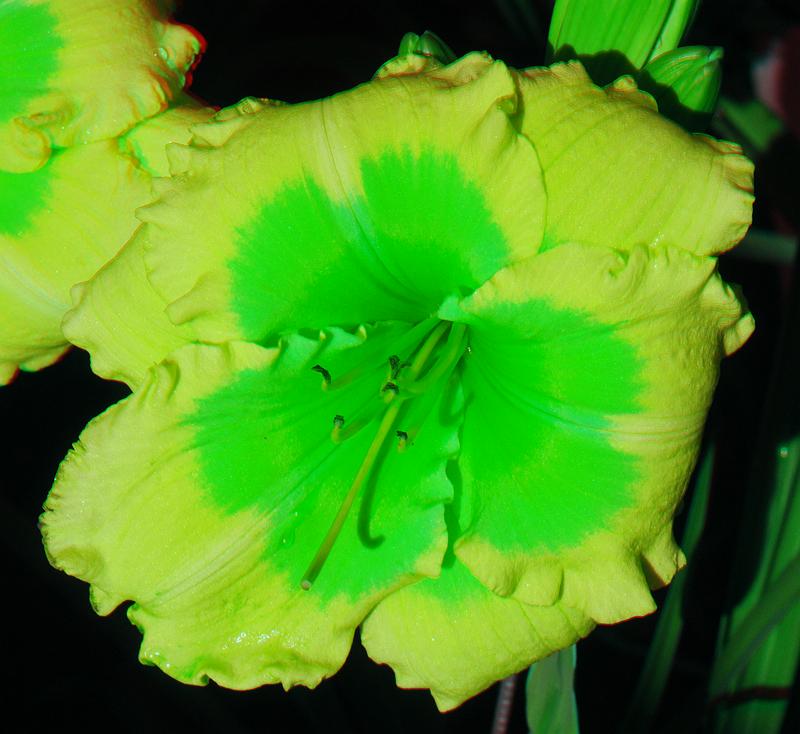

| |
| Iris 'Summer Olympics', a germanica, was here when I came and was moved from its sunless location buried under the cedars; it's a show just as the tulips fade; 60% sun. |
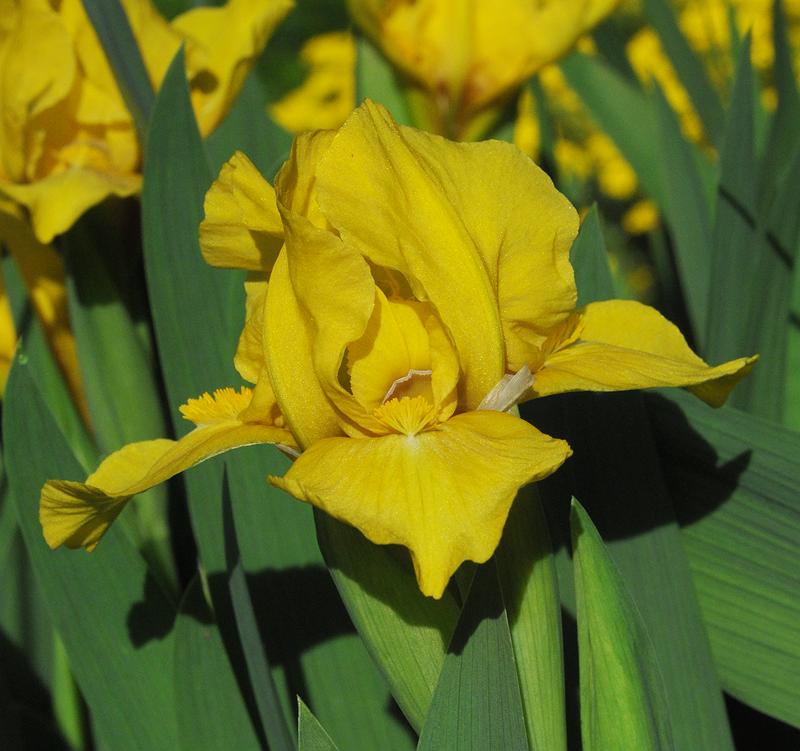

|
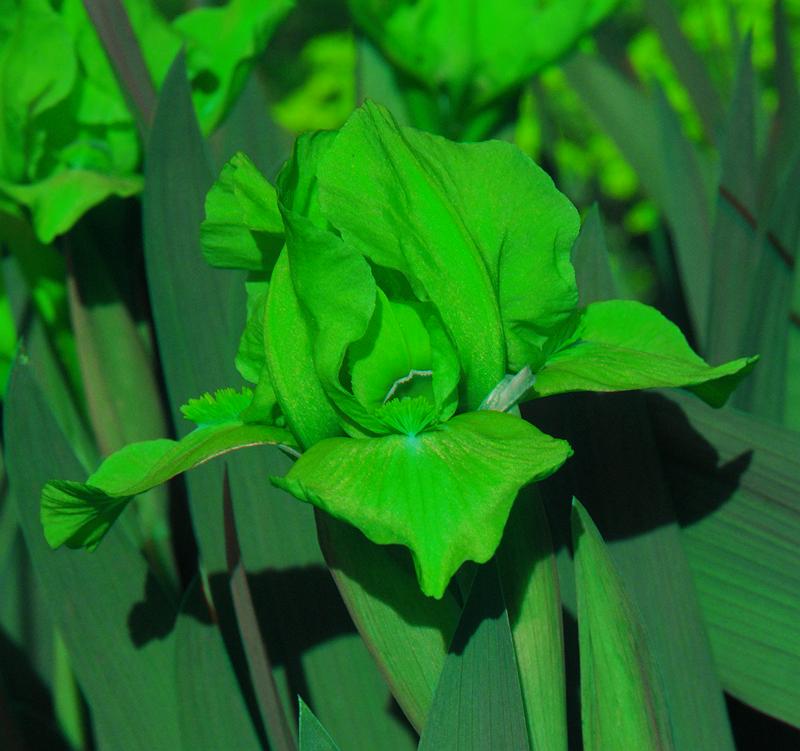

| |
| Lilium occupy the left side. Lilioceris lilii, now endemic here, emerge when the shoots are about 10 cm high and are picked off and squashed during the two week emergence period. Any grubs that do hatch are wiped off the leaf undersides as soon as they are detected. With this regimen, leaf damage is rare, but they have to be planted deep to survive the attention of chipmunks and squirrels. A layer of sand a few cm. deep reduces digging damage from my chipmunks (no guarantee with yours!); 80% sun. | |||
| Lilium 'Citronella' is a partly recurved outfacing Asiatic strain originating from L.davidii ×L.amabile hybrids; stems of small bulbs (offsets) are a bit weak for the weight of blooms they produce, but mature bulbs are fine; flower diameter 110 mm. |
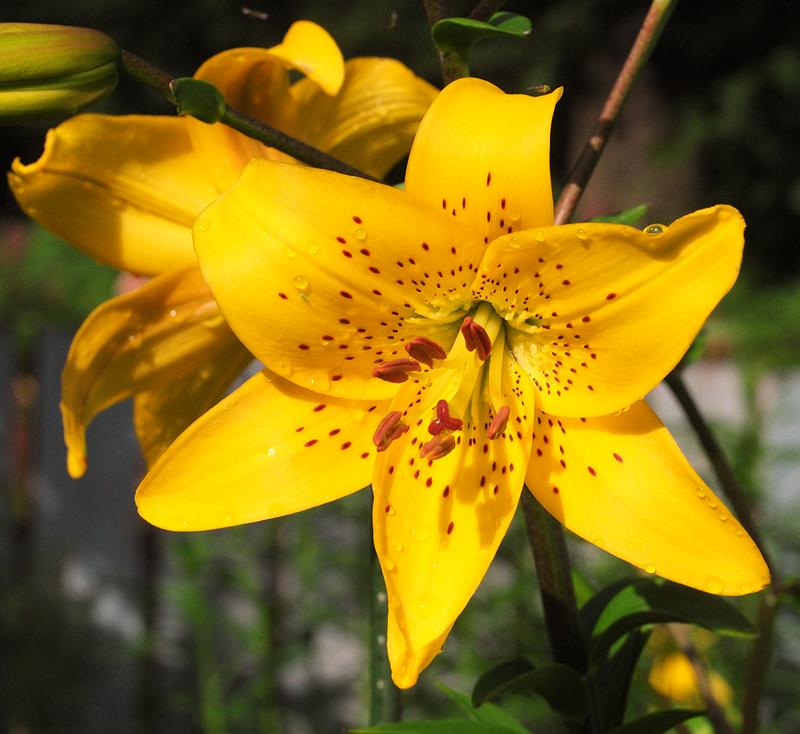

|
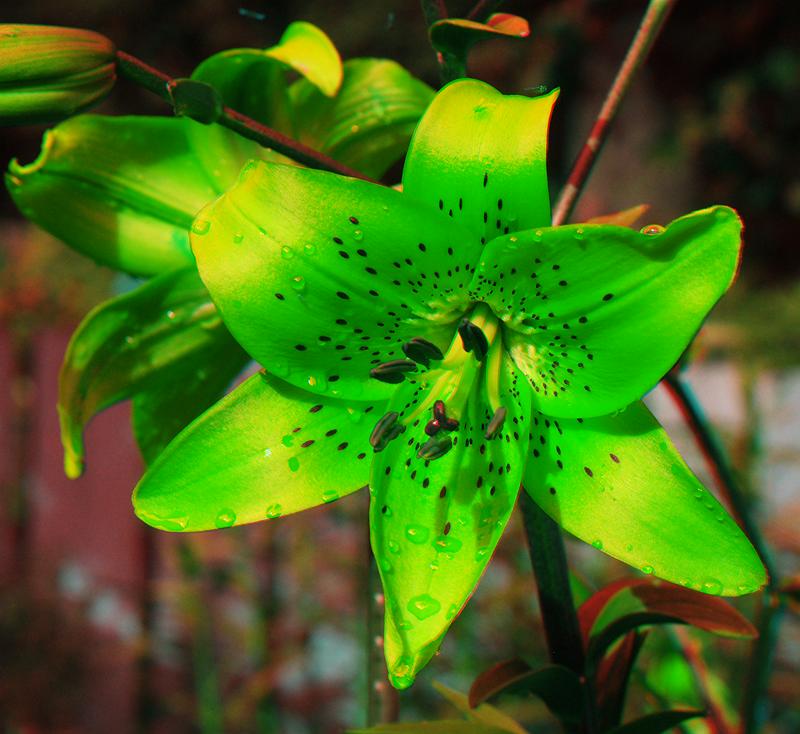

| |
| Lilium 'Pearl Melanie' is a 2 m high tetraploid outfacing Asian, windfirm despite its height; flower diameter 130 mm. |
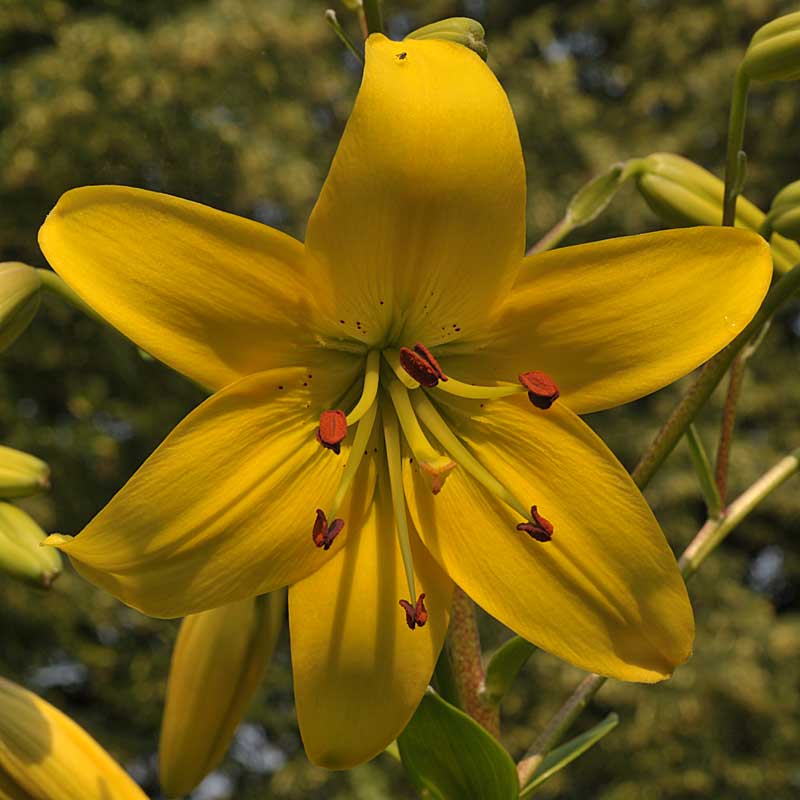

|
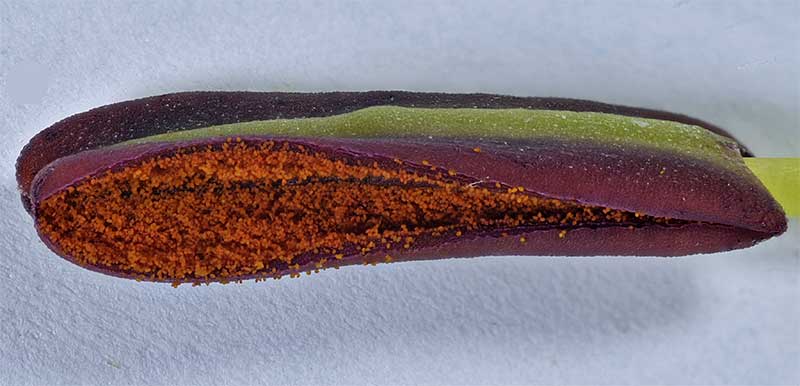

| |
| Lilium 'Pixie Yellow' is a vigorous upfacing Asiatic with compact growth that readily forms a wind-firm tight clump. Pixie was a trademark of Cebeco Lilies for a series of about 20 hybrids; it was abandoned in 1992, and many commercial names still include it; flower diameter 160 mm. |
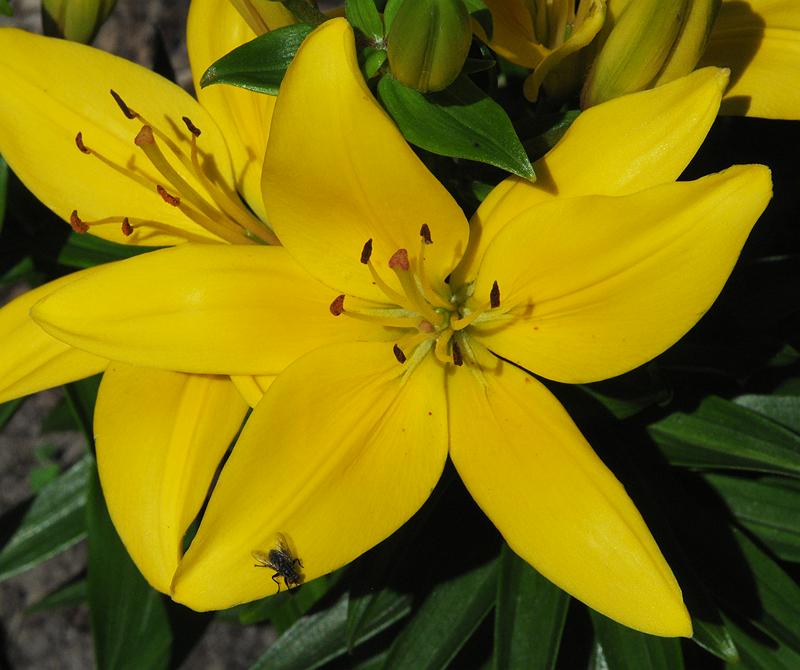

|
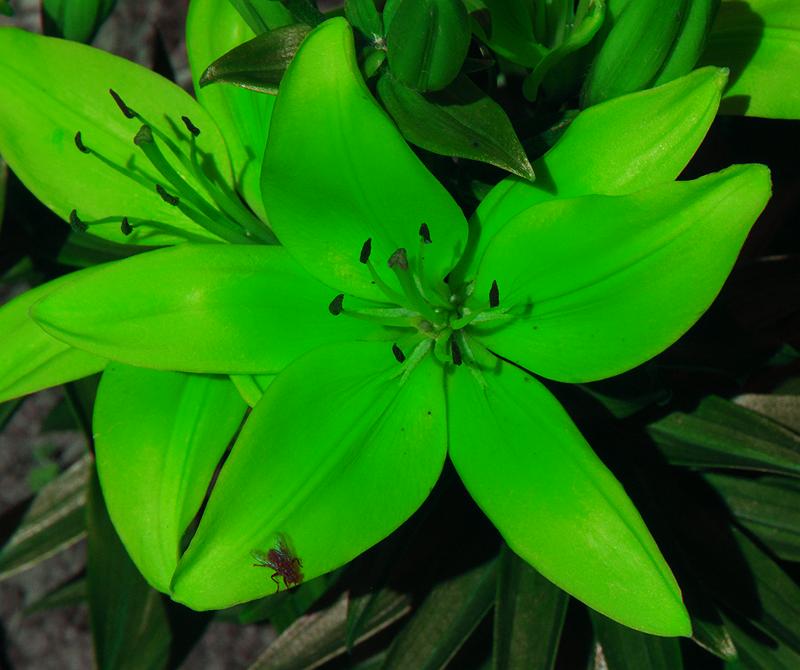

| |
| Lilium 'Yellow Power' is a 2 m tall outfacing light yellow; flower diameter 150 mm. |
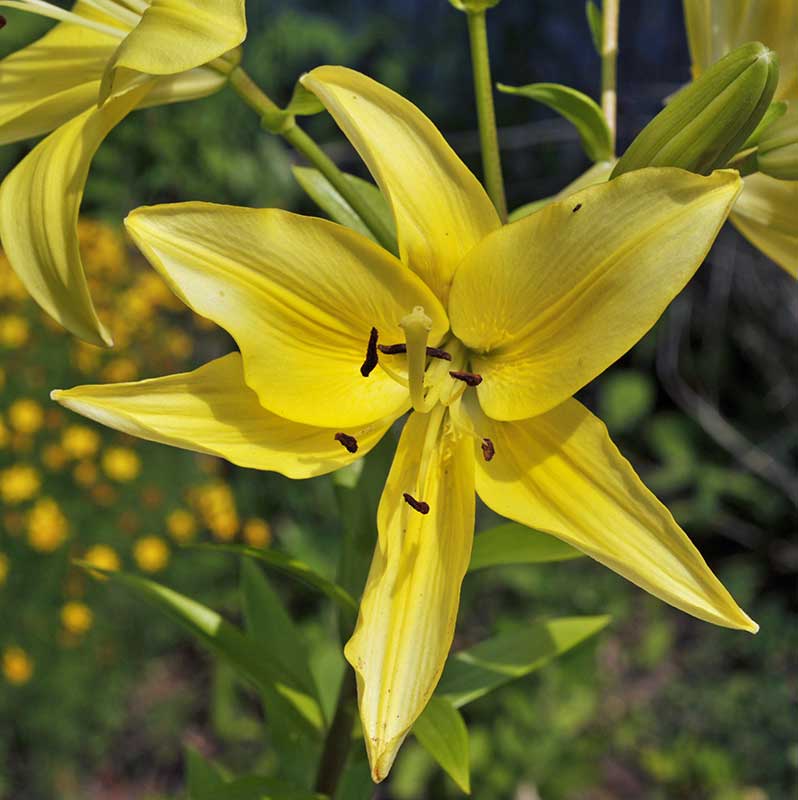

| ||
| Narcissus mixture: a mixture of early, mid and late varieties, mostly 1Y-Y, fills the center of the garden; 70-90% sun. |
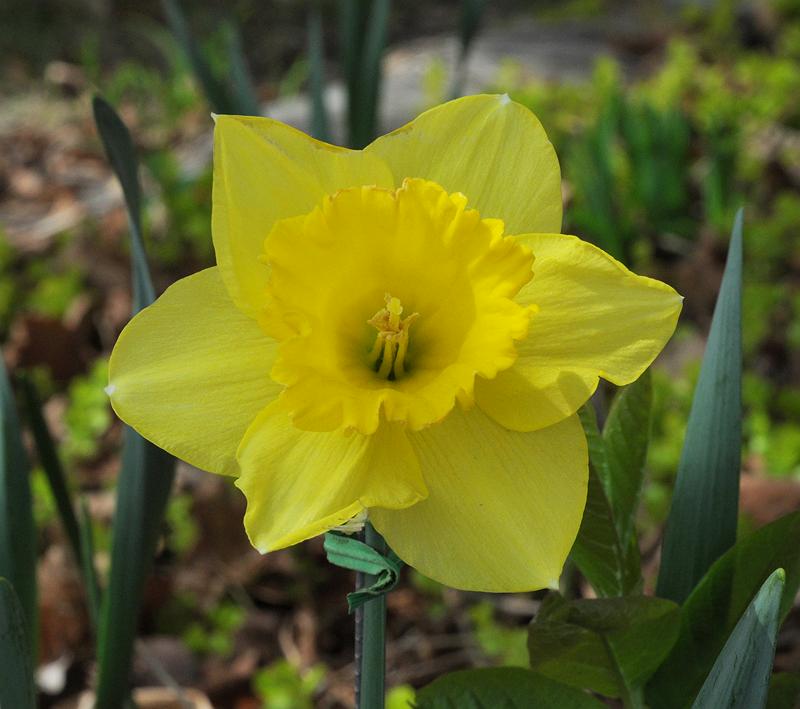

|
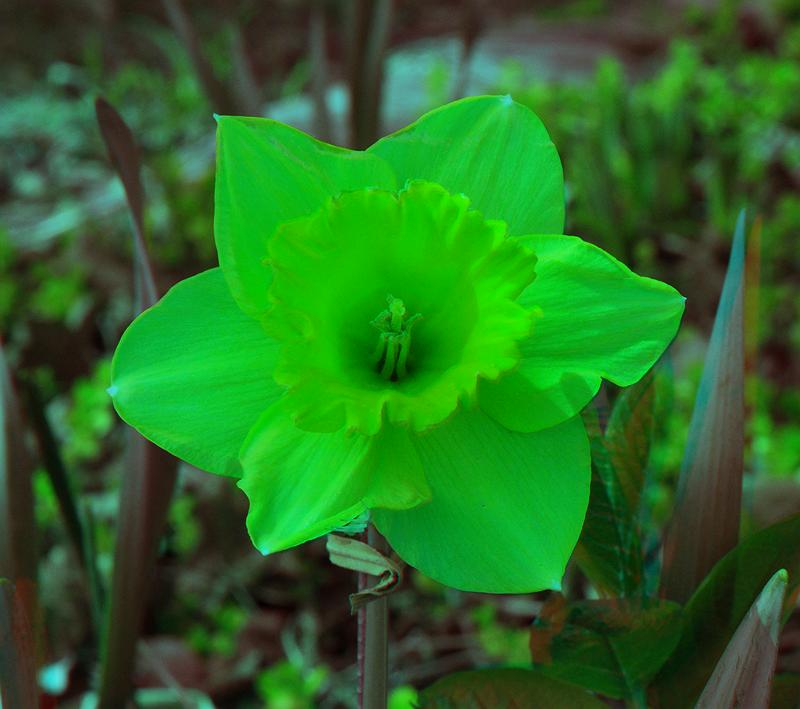

| |
| Narcissus miniatures fill the front of the garden; 70-90% sun. |
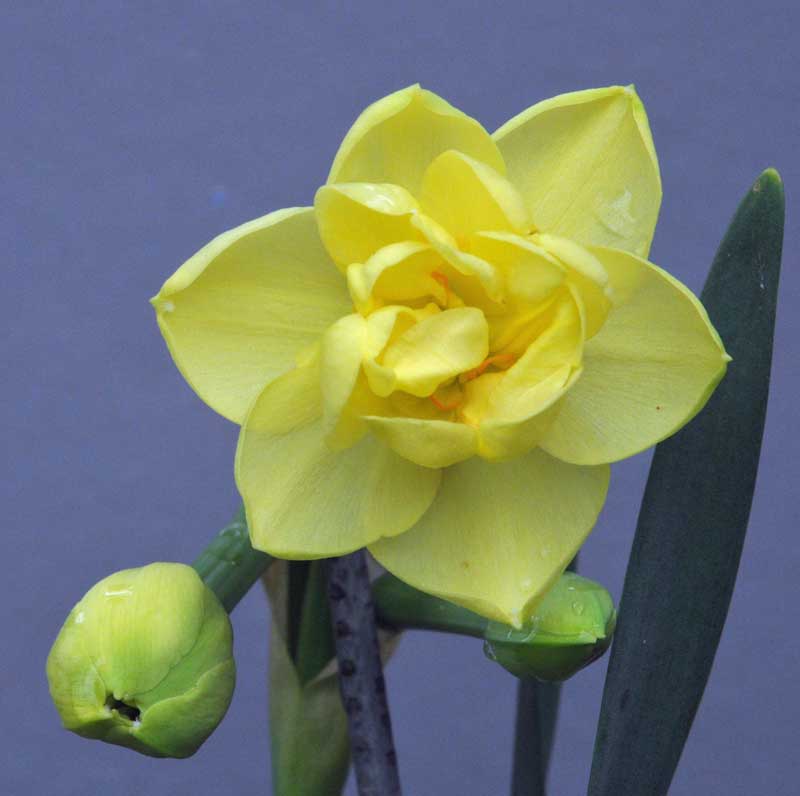
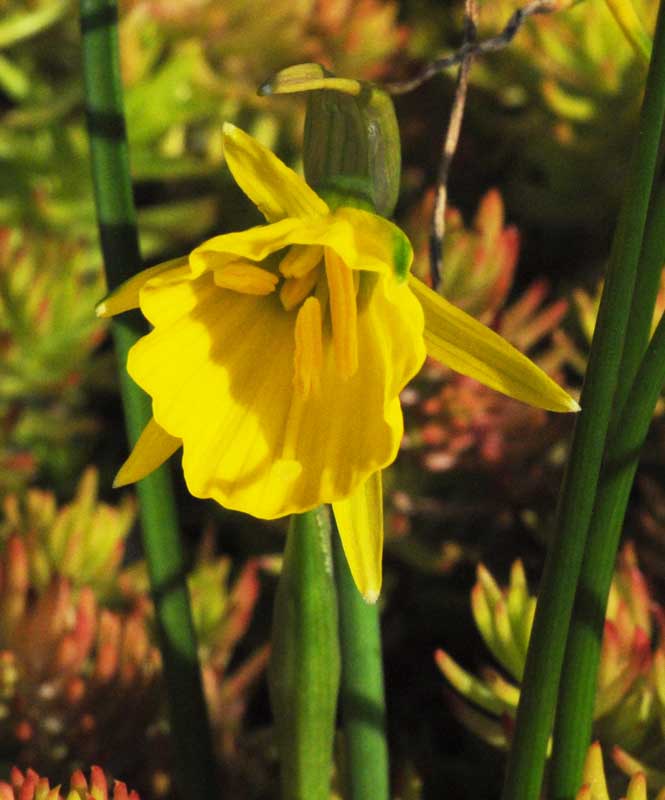
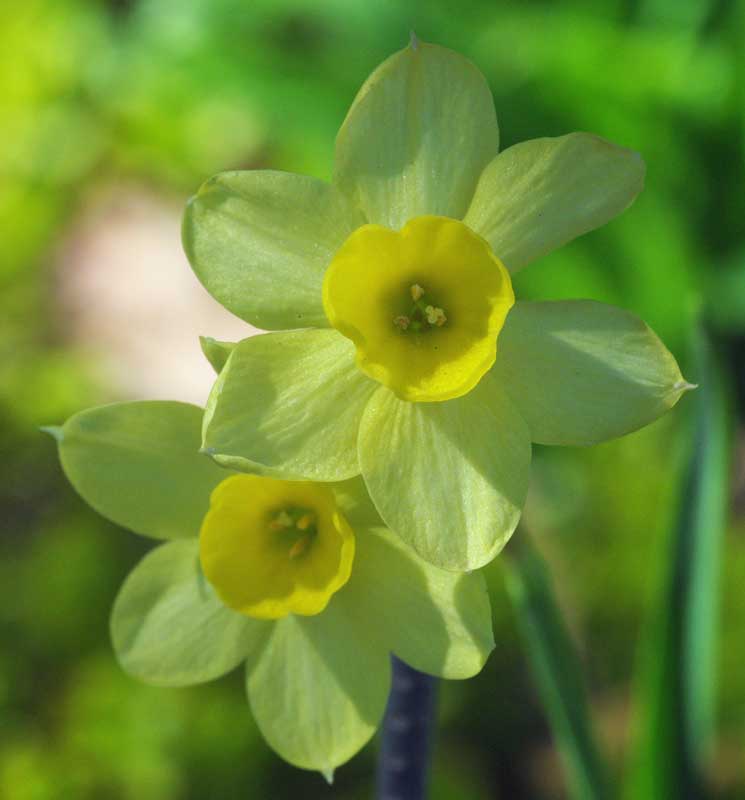
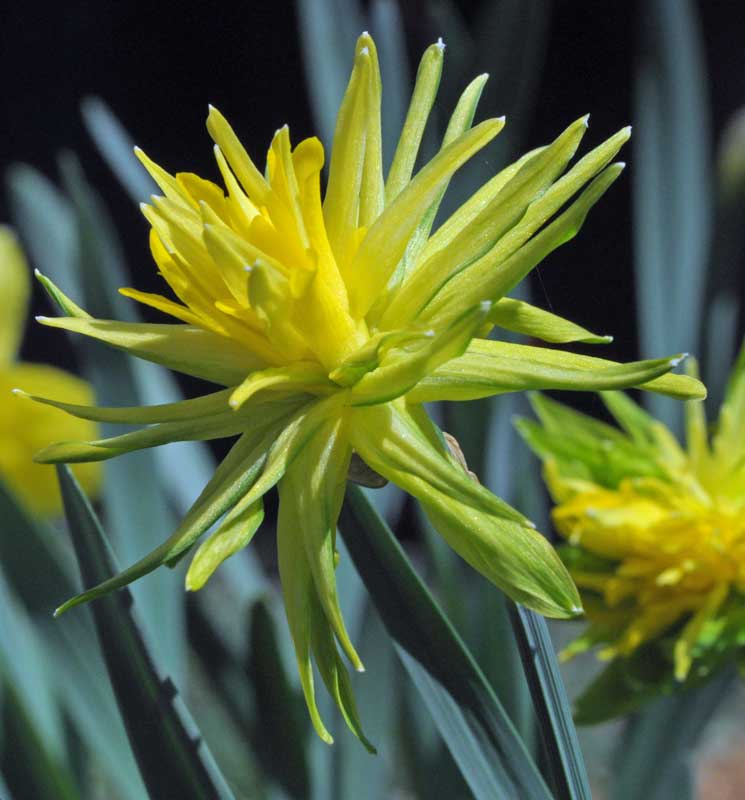
|
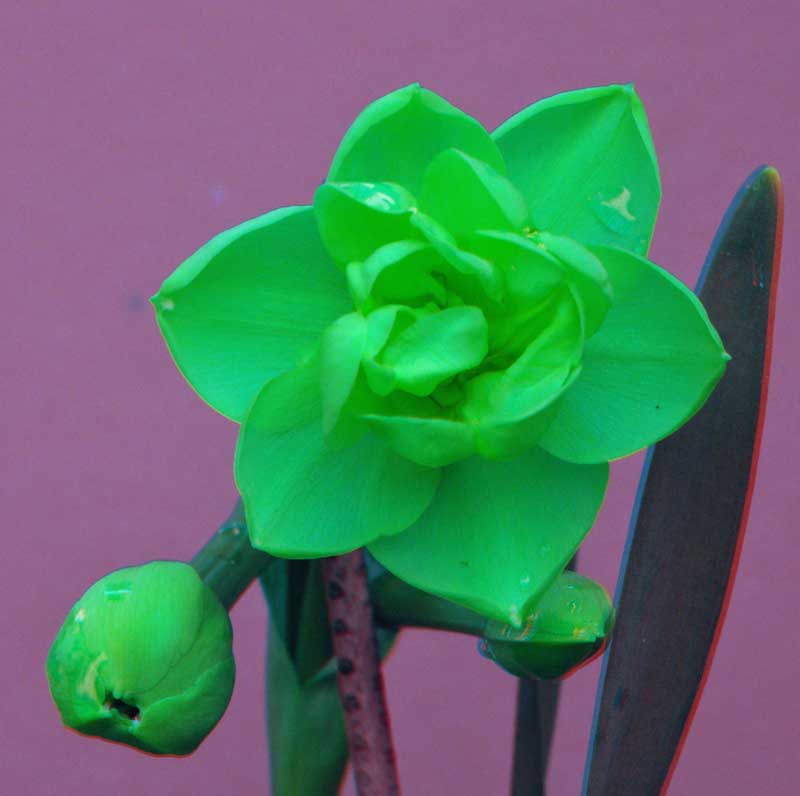
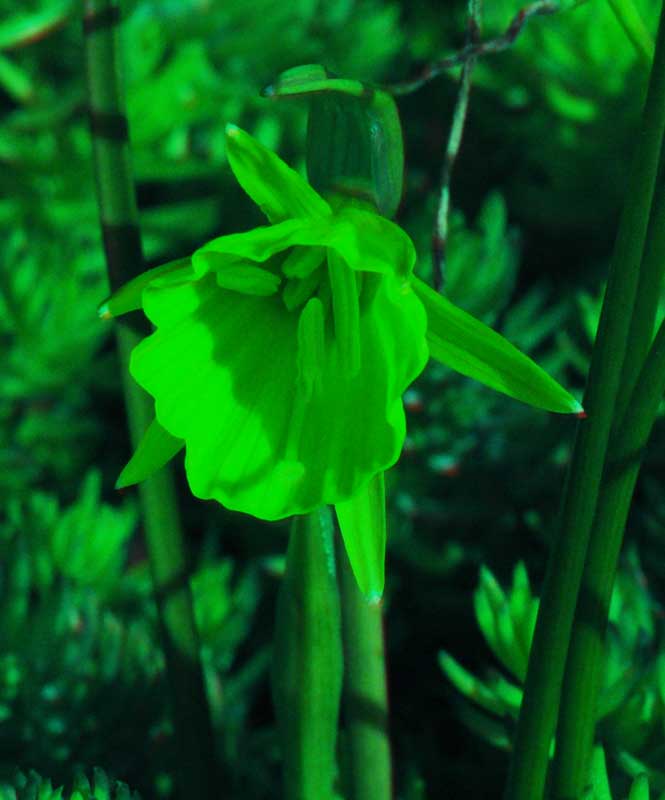
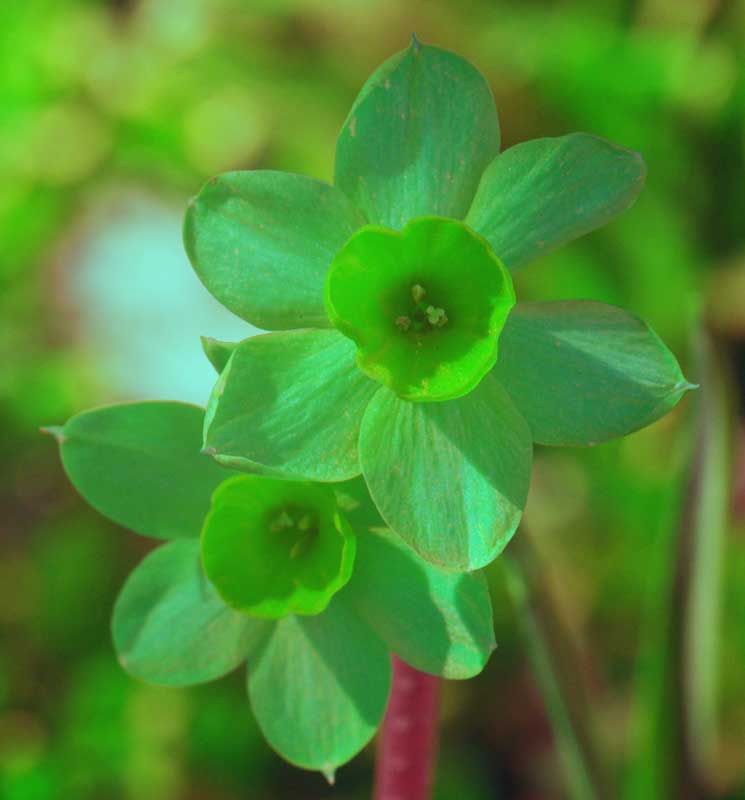
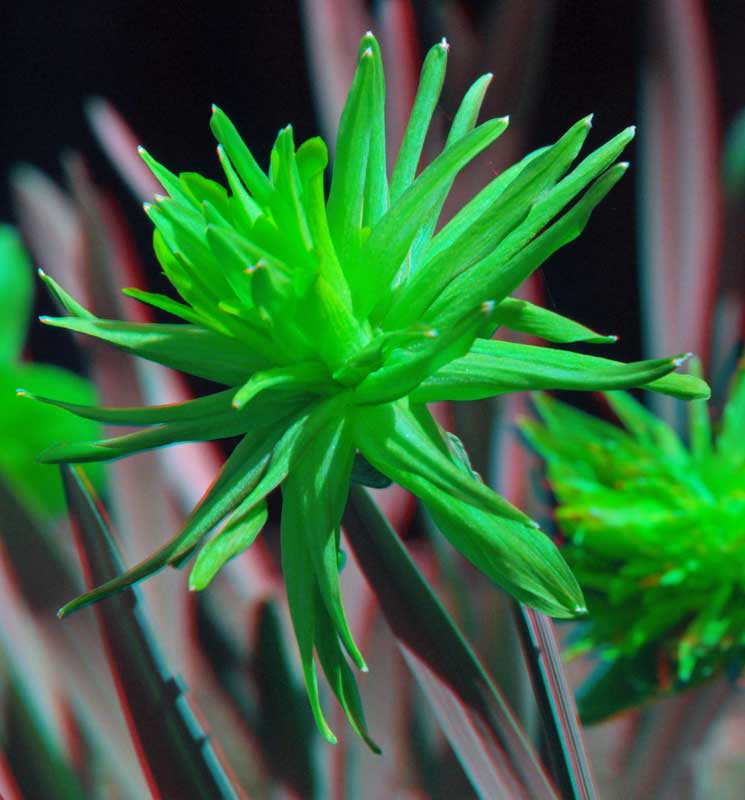
| |
| Sedum floriferum (Phedimus florifer) from China is under the front section; botanists consider it conspecific with S.kamtschaticum, but gardeners won't: its growth pattern is very different, taller and denser, its blooming period is far shorter and its seed heads are dead looking black rather that the crisp deep red of S.kamtschaticum. Also, it gets black terminal rot in soggy weather; S.kamtschaticum doesn't; flower diameter 18 mm. |
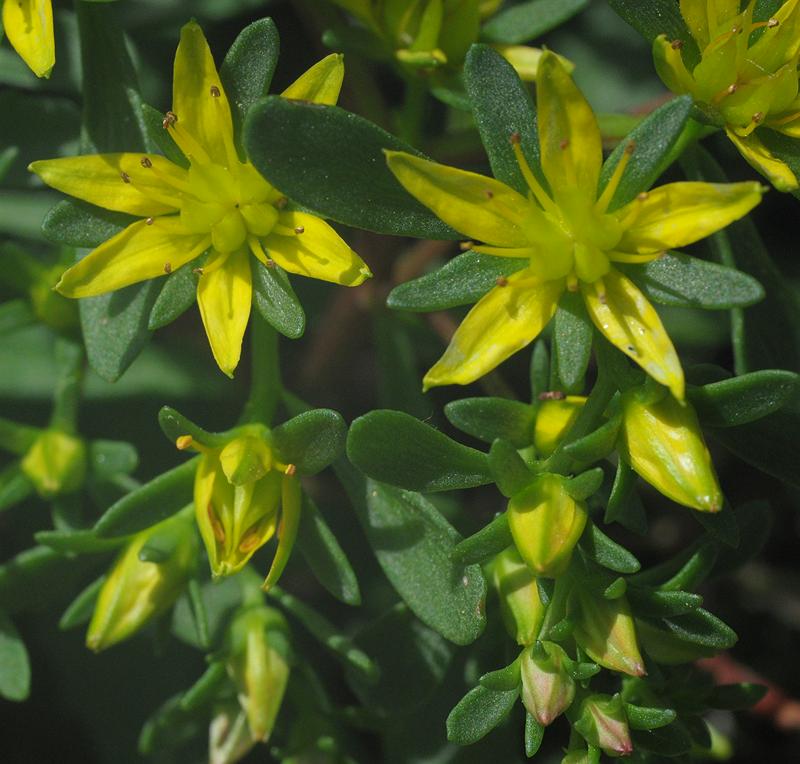

|
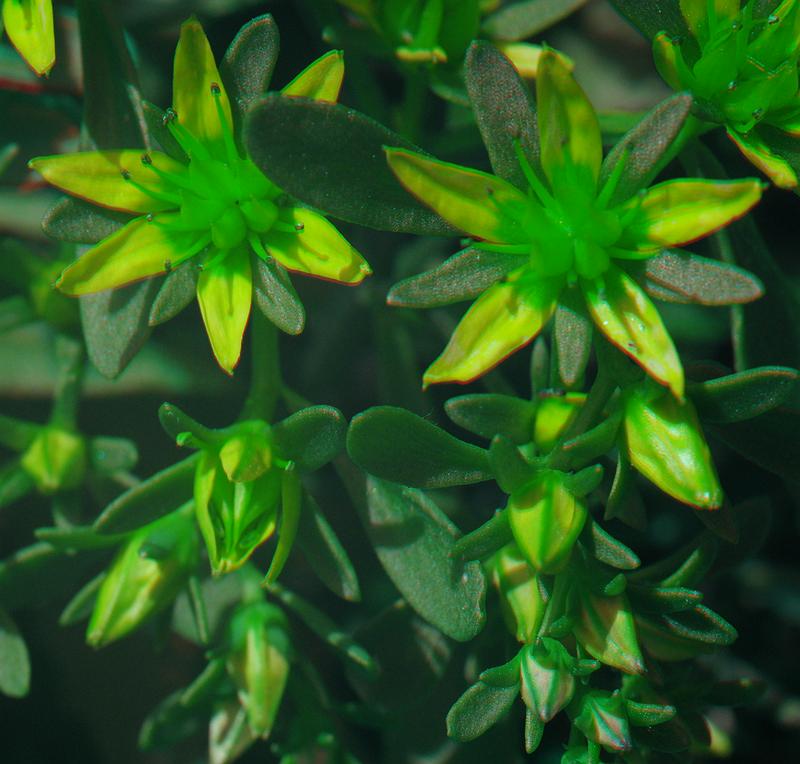

| |
| Sedum hybridum (Phedimus hybridus) from northern Asia is under the back section. It looks great in June, but by mid August has almost totally died back leaving an unsightly tangle of dead stems. I'm replacing it with Ranunculus repens; flower diameter 18 mm. |
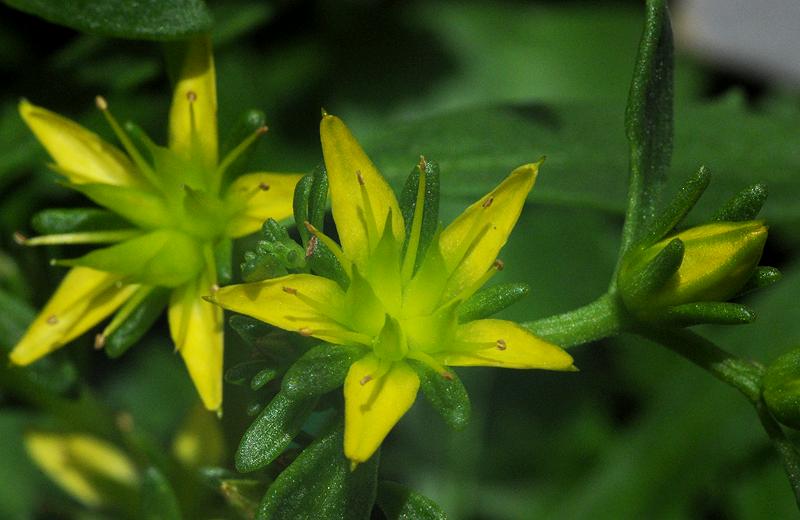

|
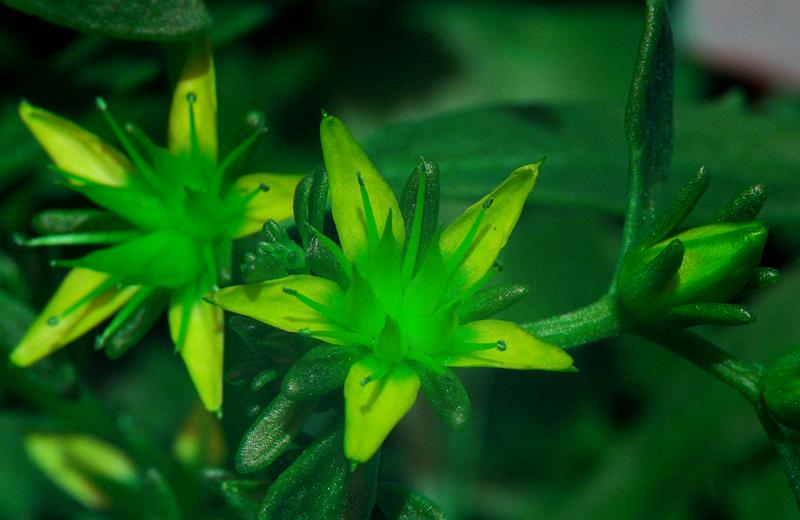

| |
| Tulipa clumps used to dominate the front but due to squirrel predation are gradually being replaced by mini-Narcissus; 70% sun. All tulips are attractive to grey squirrels, which I have in abundance. With the help of a thin layer of cocoa shells, whose smell seems to confuse squirrels, some keep up with predation, but squirrels also eat the blooms of short species. Thick layers of cocoa shells go mouldy, but thin layers are an excellent soil amendment for bulbs. (Don't ever get the ground-up version; it's instant mould, cakes into a wrinkled layer and looks terrible.) | |||
| Tulipa urumiensis, native to Iran, is one of the shortest dwarf tulips but isn't multiplying here; Bombylius major love it when it's out |
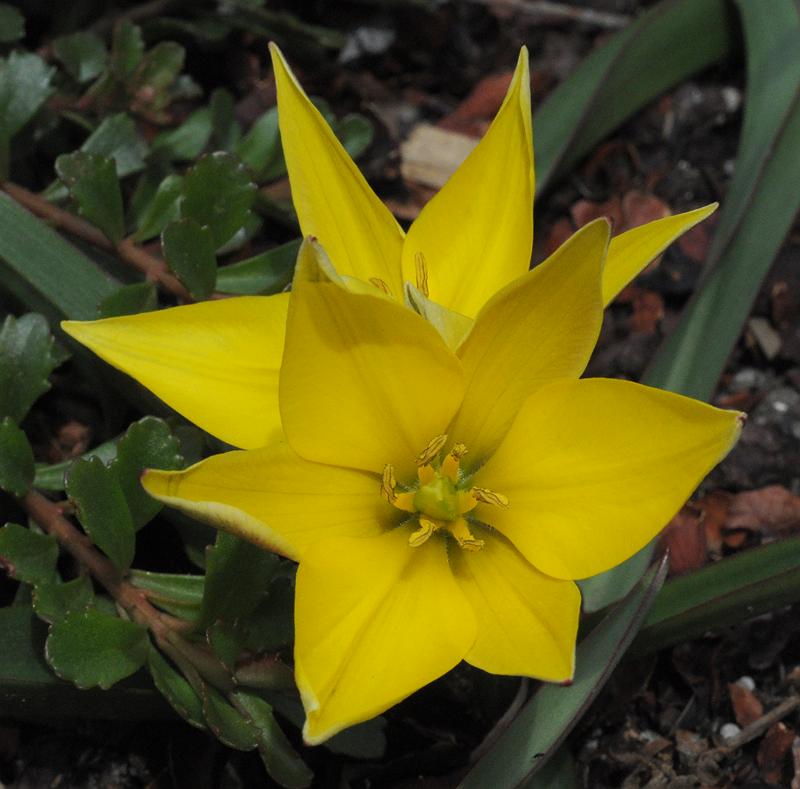

|
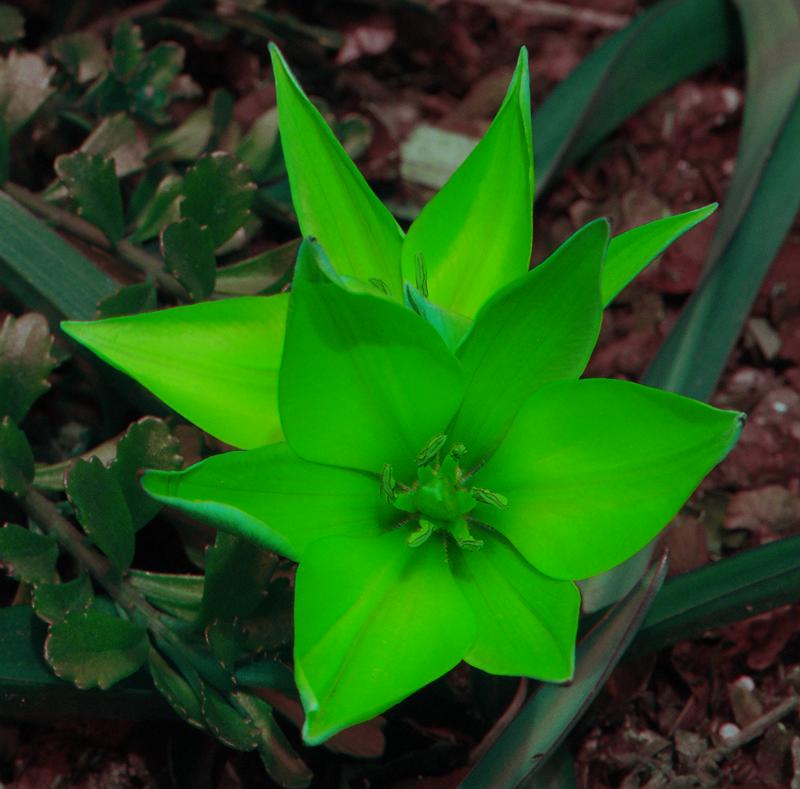

| |
| Tulipa 'Jaap Groot' is a mid-season mutation of Golden Apeldoorn, a Fosteriana-Darwin hybrid. Its petals open so wide during warm days they look as though they're ready to fall off, but still close up normally at nightfall |
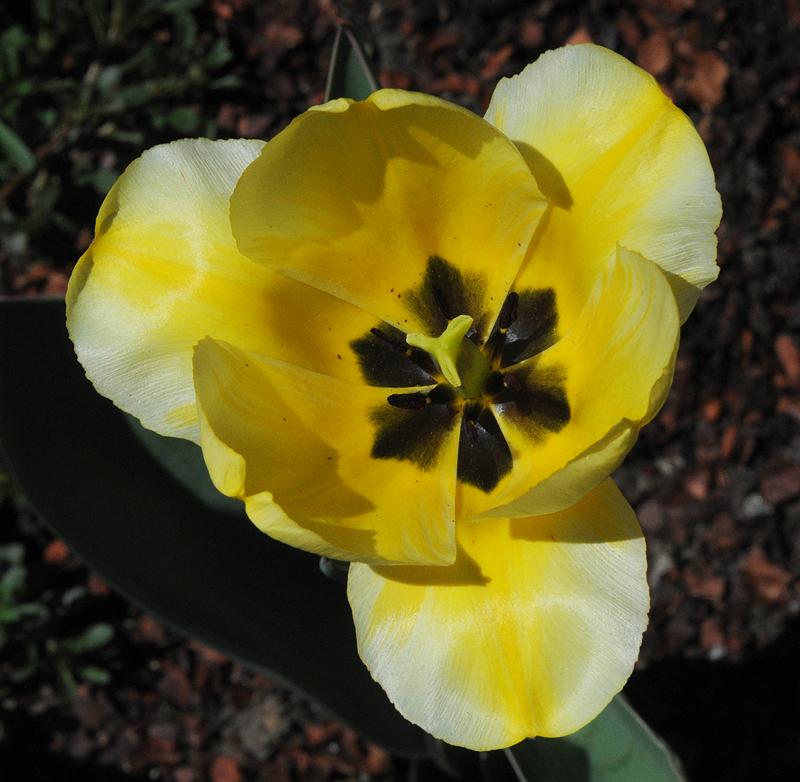

|
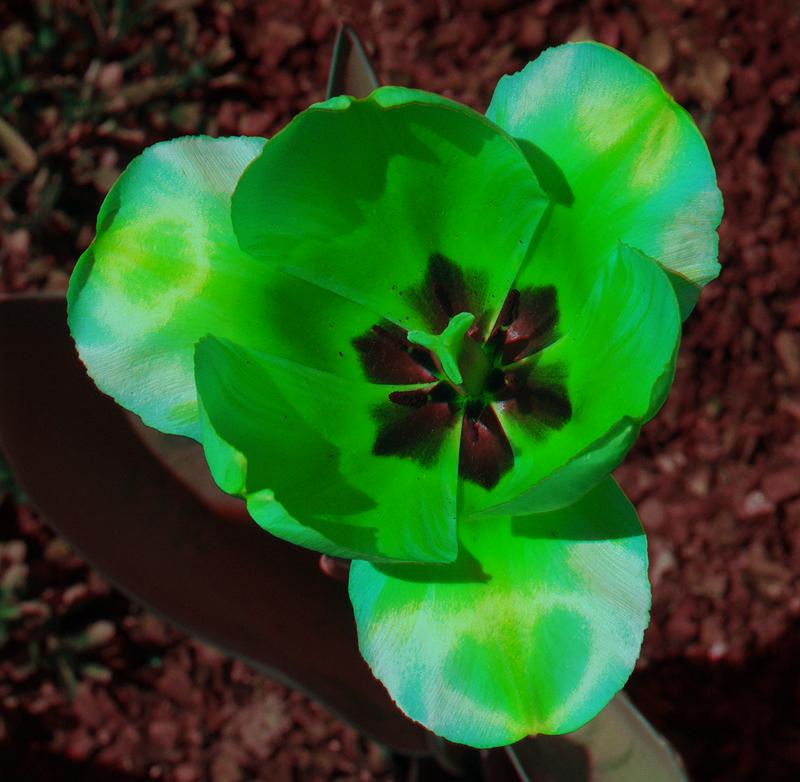

| |
| Tulipa 'Roi du Midi' is a long-stemmed late sport of La Courtine; it stays open later than any other I have and stands up to heavy rain well |
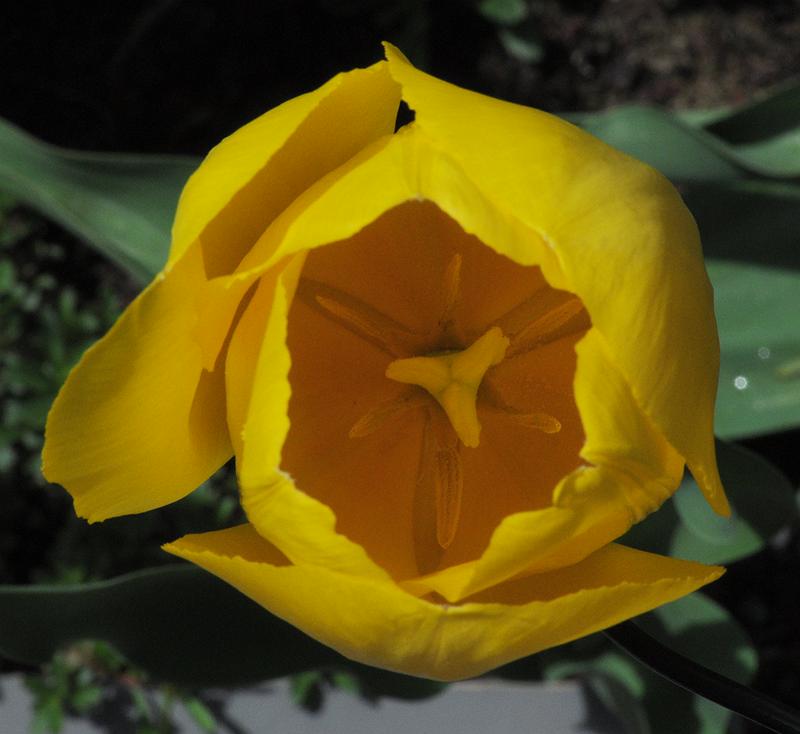

|
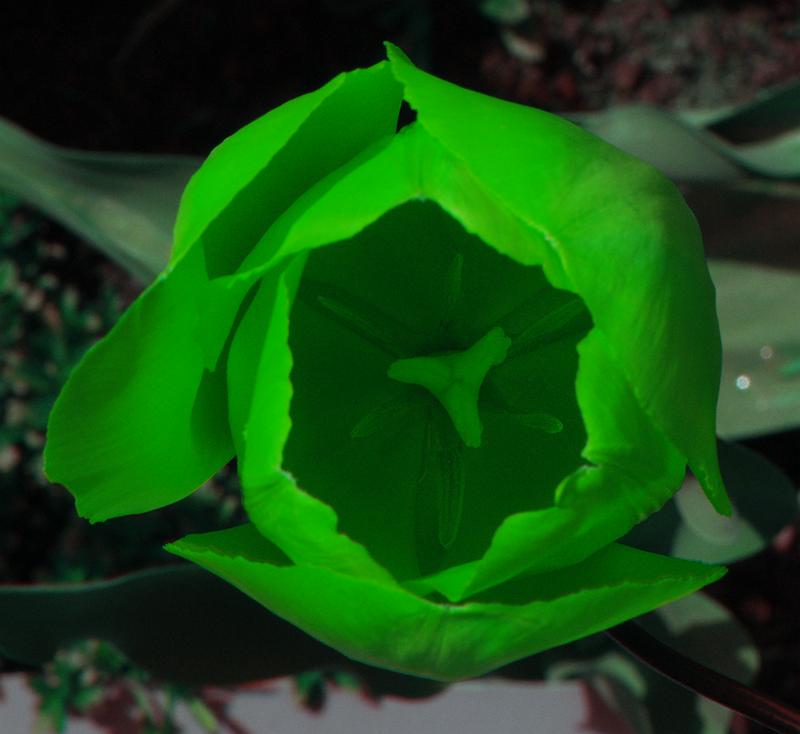

| |
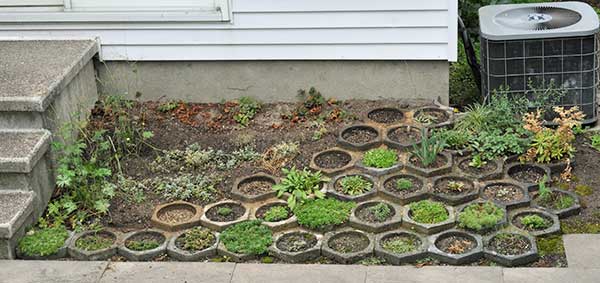
| mouseover thumbnails for full images
human insect |
| Alyssum montanum from the Mediterranean is growing behind the pots. Many plants are straggly, but once I found one with acceptable form, it's a show most of the year. It grows best in dry rocky soil; pH seems unimportant. It blooms from early May through to hard frost, longer than any other plant I have; flower diameter 8 mm; 20-40% sun. |
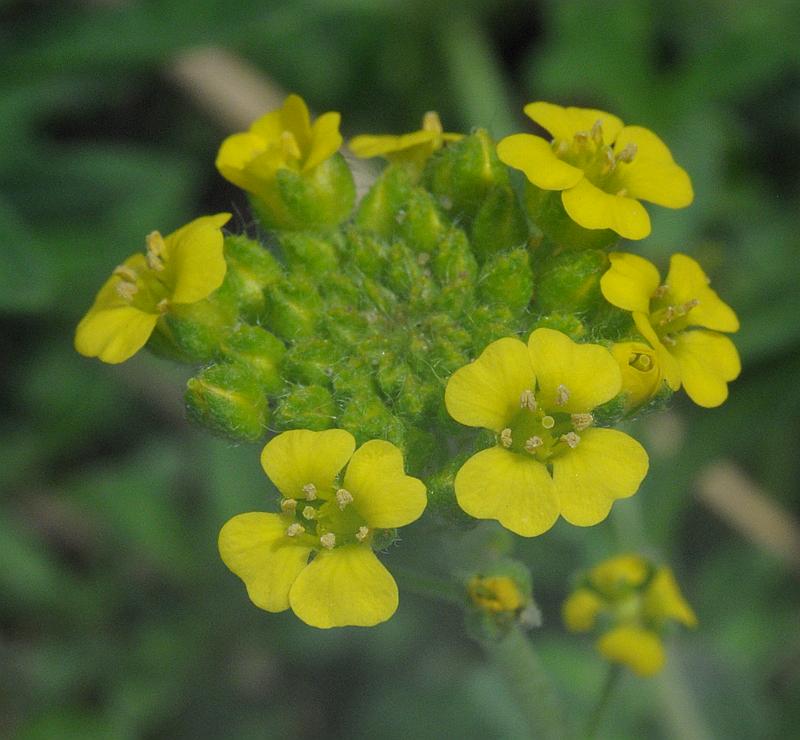

|
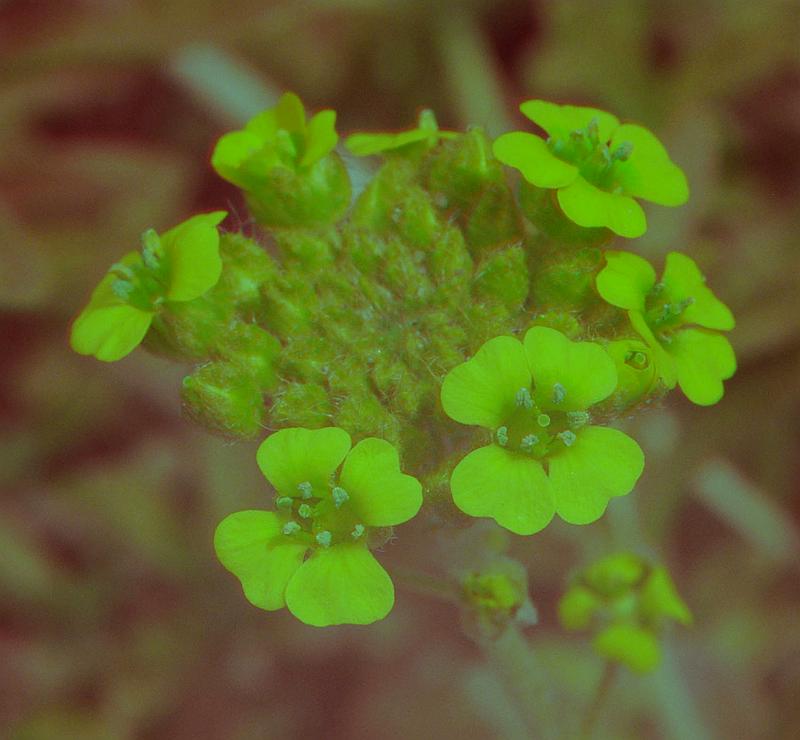

| |
| Draba bruniifolia olympia is native to lime-rich soils of the Caucasus |
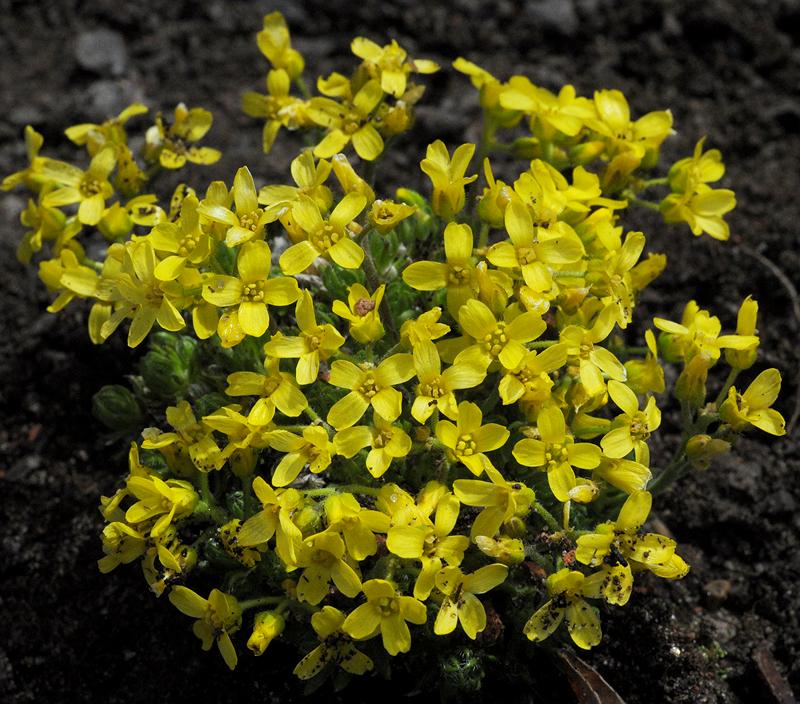

|
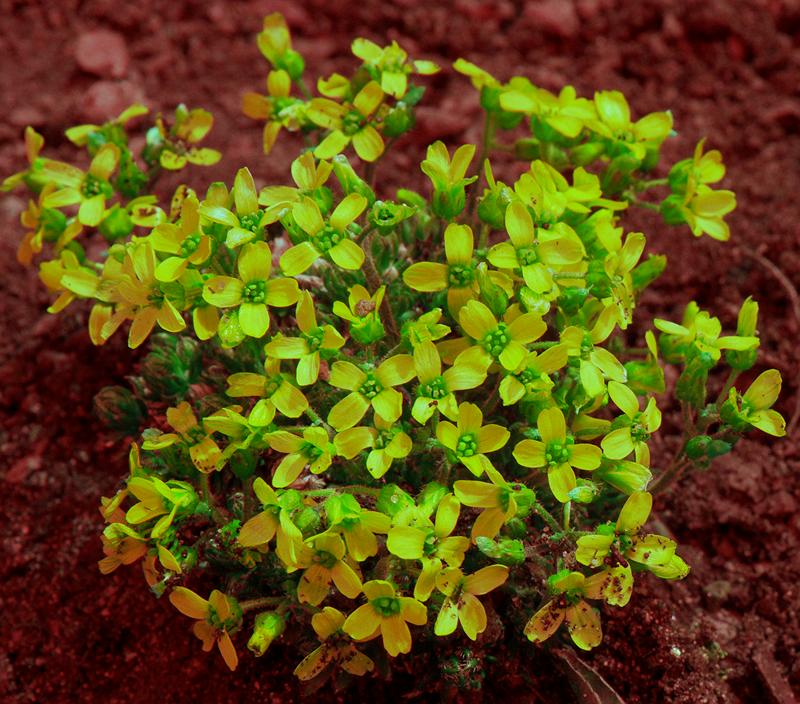

| |
| Draba cuspidata is native to the north side of the Black Sea and prefers dryish sandy loam. |
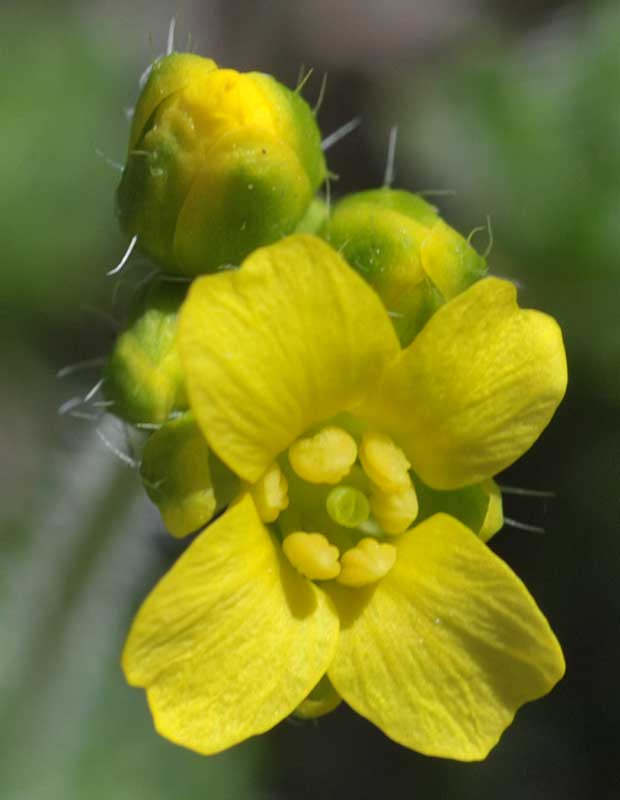

| ||
| Draba 'Judy', a mostly D.aizoides hybrid from Judy Wall, also has yellow seed pods as well as flowers |
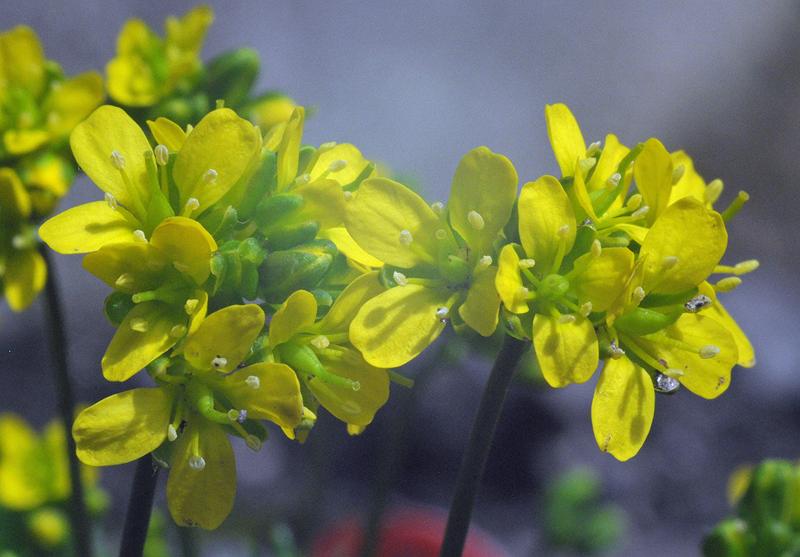

| ||
| Draba mollissima is native to the Caucasus, in dry mountain areas among rocks and in crevices. |
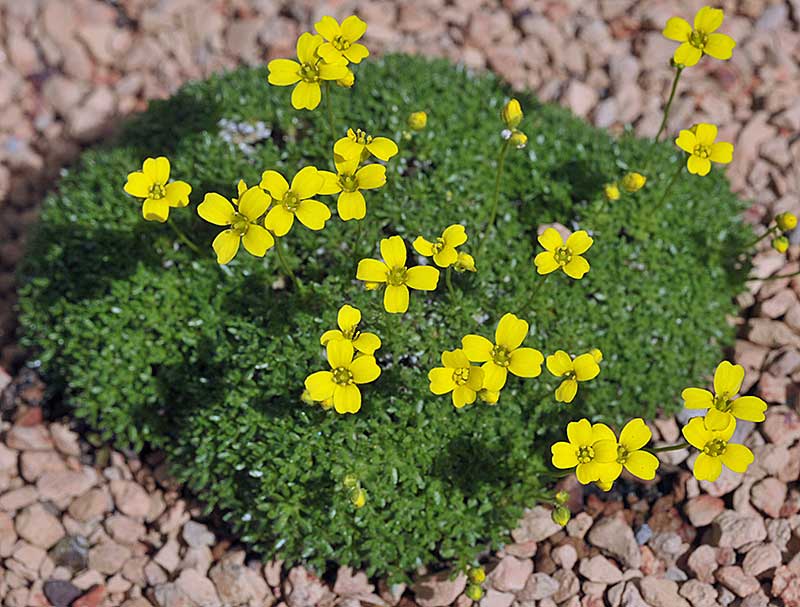

|
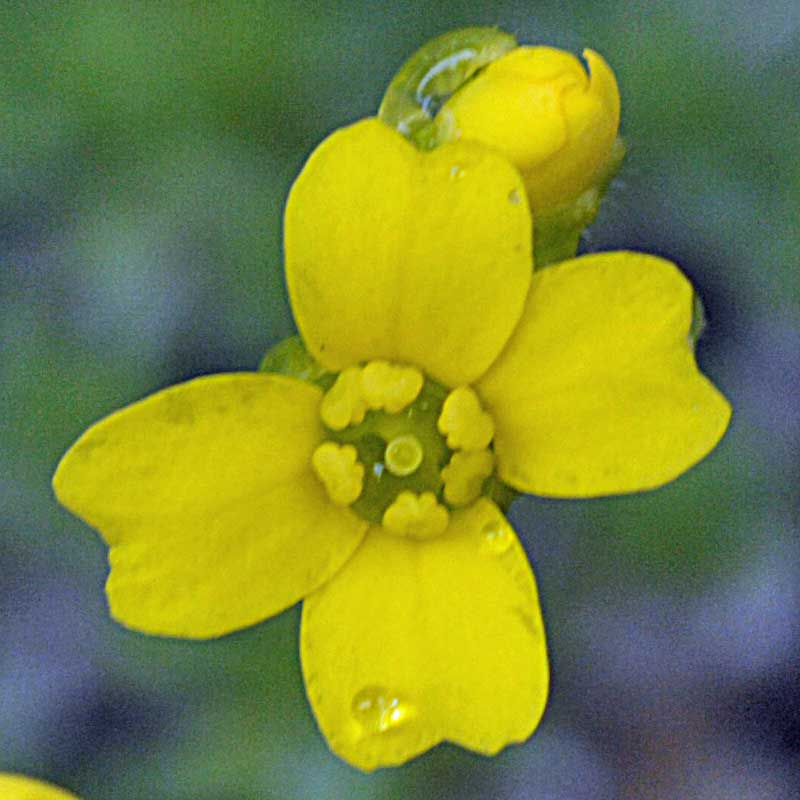

| |
| Draba 'Simon' is a hybrid from Wrightman |
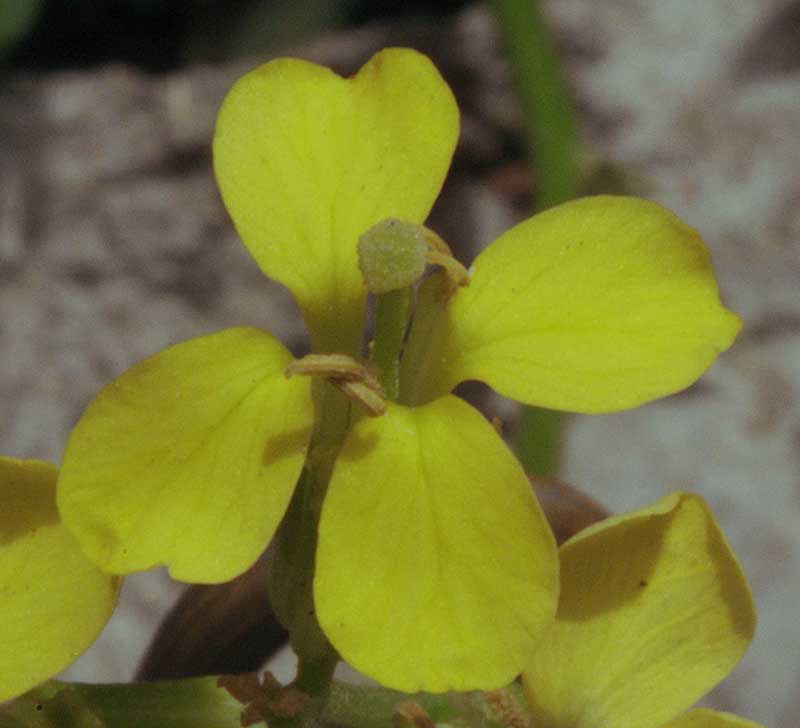

|
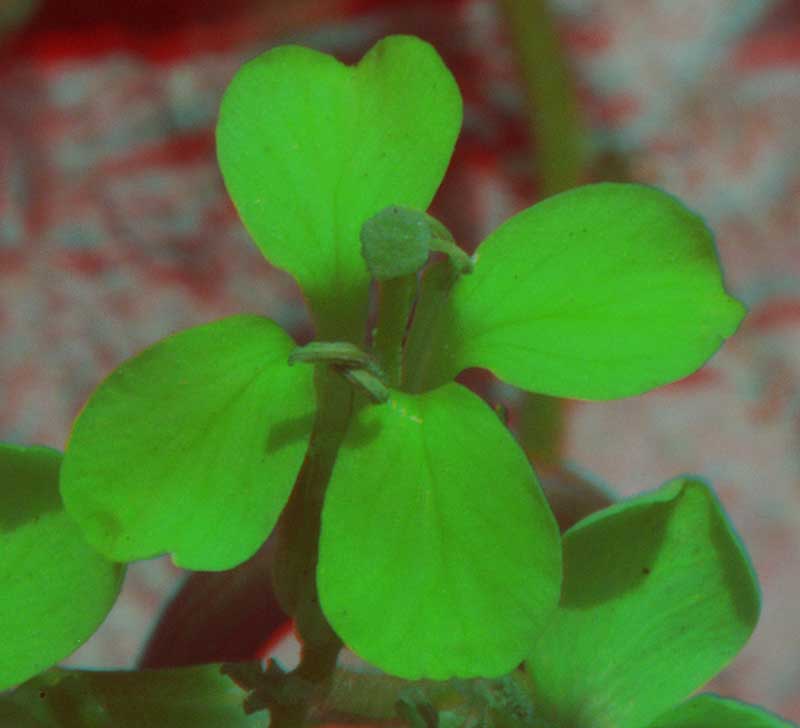

| |
| Erysimum kotschyanum is from hot dry sites in high mountains of Turkey; flower diameter 9 mm. |
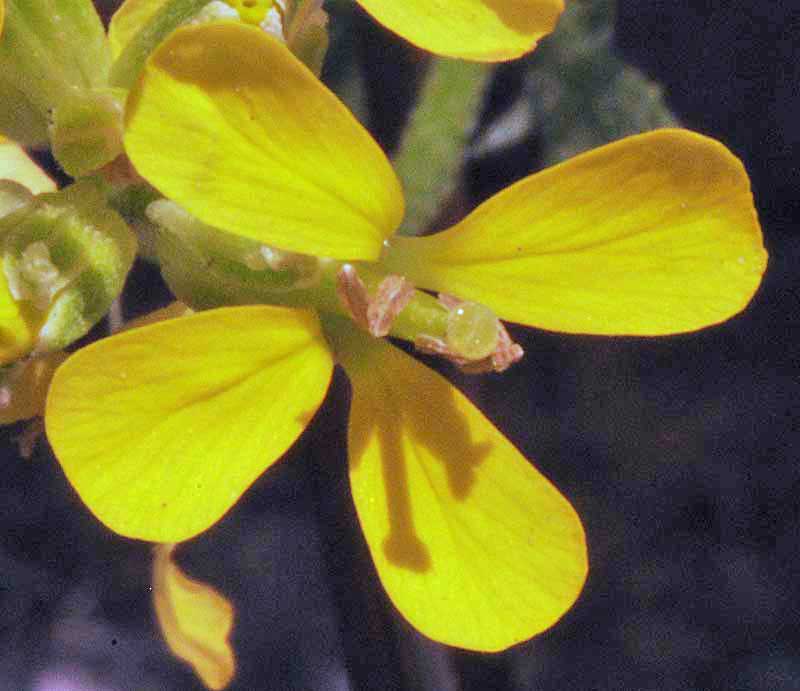

|
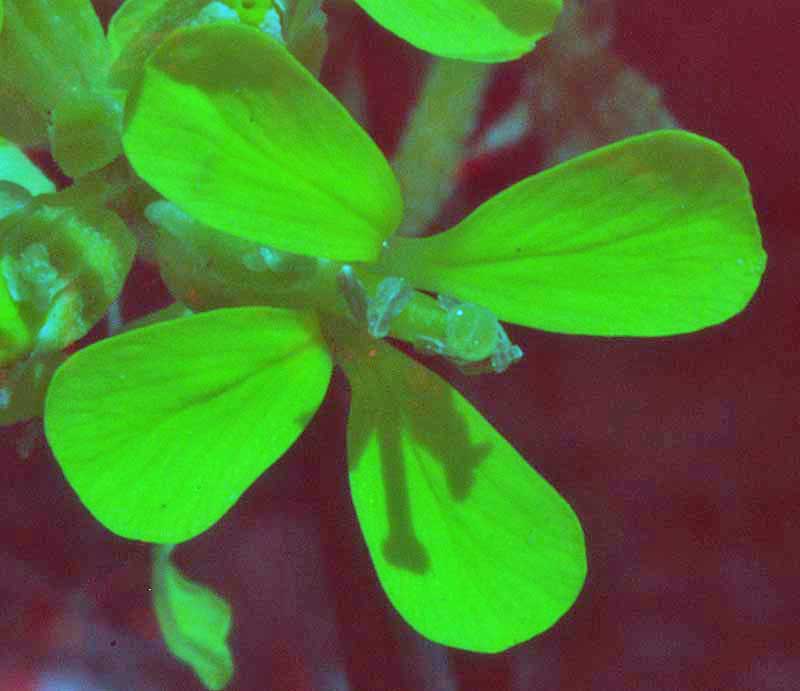

| |
| Euphorbia cyparissias is native to Europe. It's invasive, so needs a location where it can be controlled. |
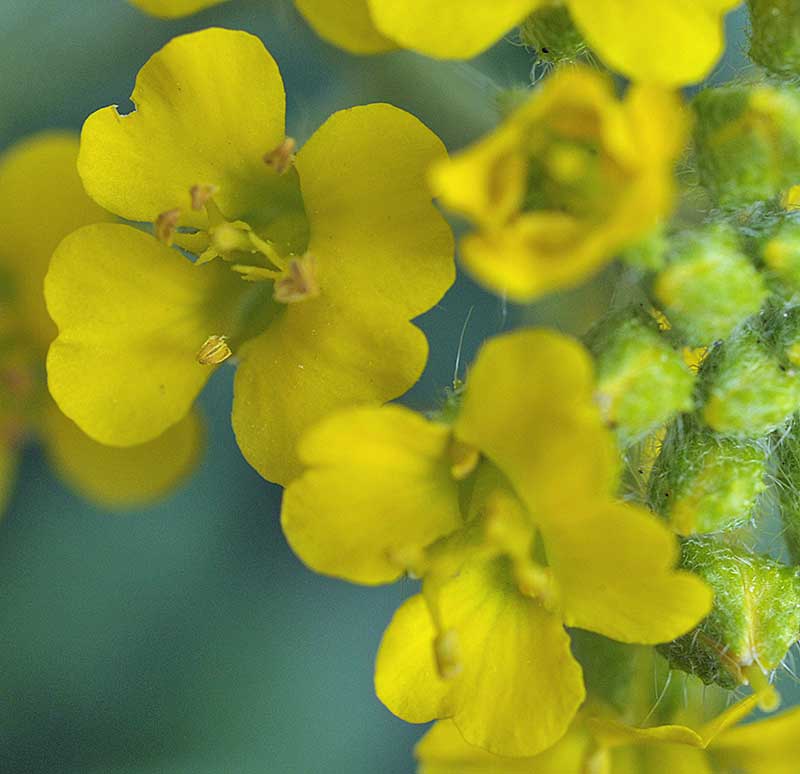

| ||
| Genista radiata is native to northern Italy. |
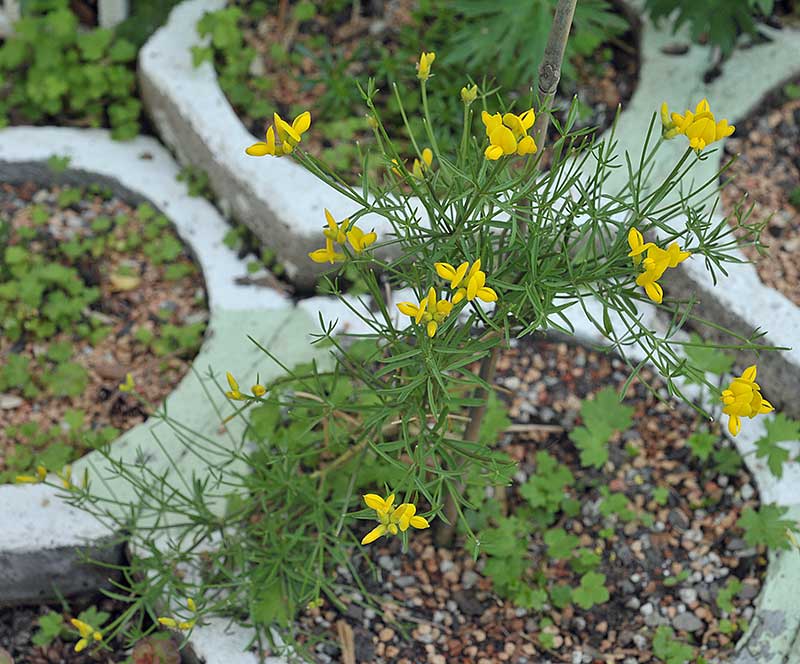
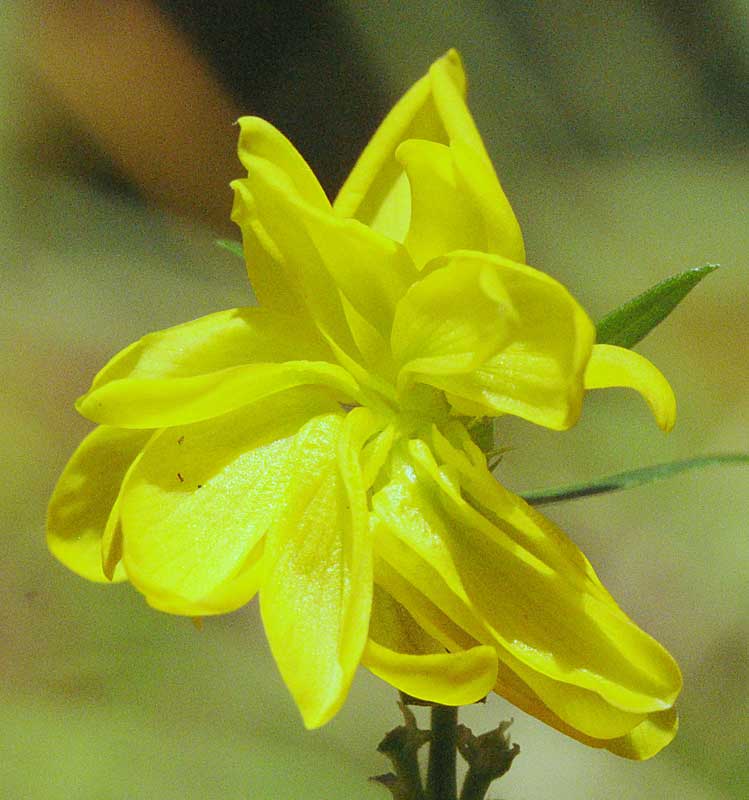
|
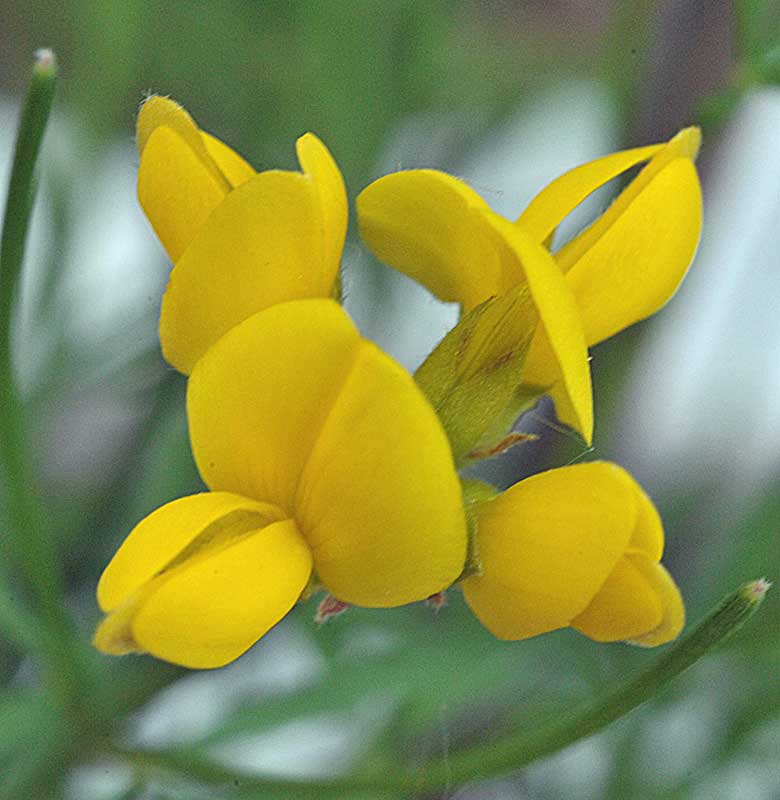
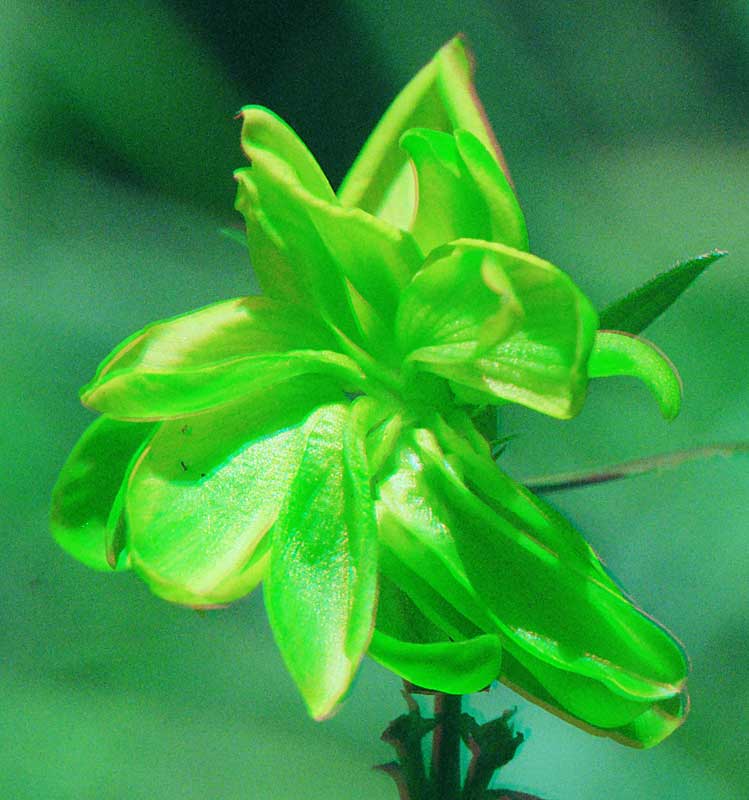
| |
| Genista tinctoria 'Plena' is a dwarf double sport of a species originally from European Turkey that prefers sandy alkaline soils; diameter 15 mm. |


|


| |
| Hymenoxys lapidicola is from quartzite and granitic sandstone areas of Utah; umbel diameter 18 mm. |
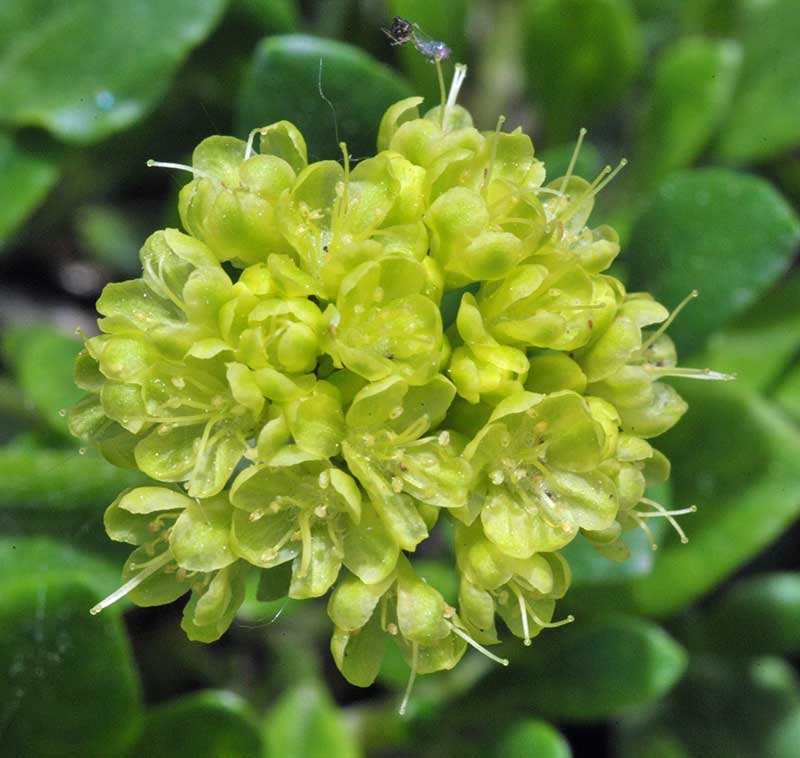

|
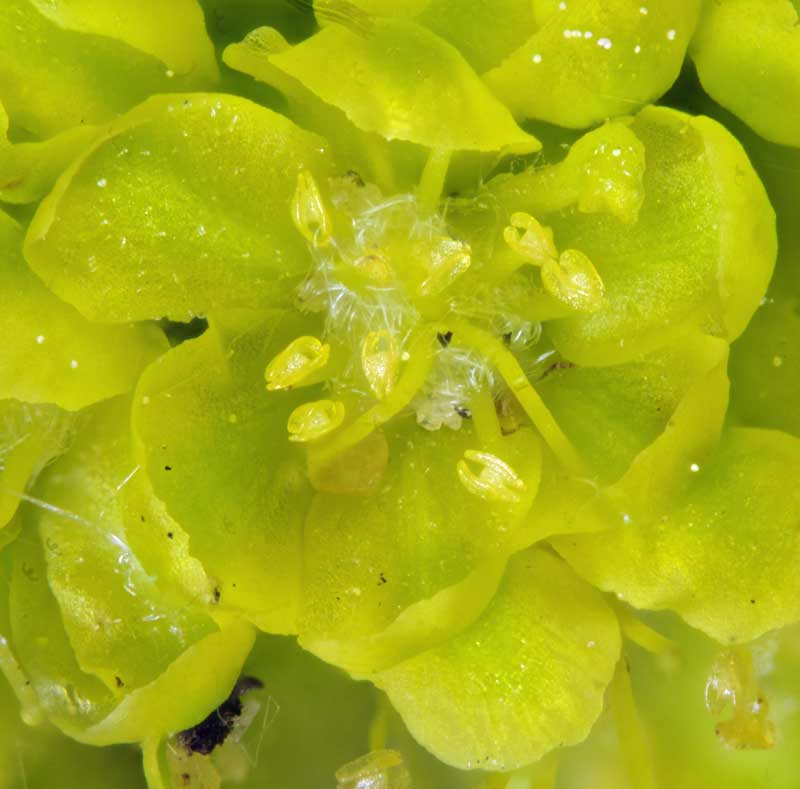

| |
| Hypericum coris is a shrubby native of the limestone maritime and southern Alps from 700-2000 m; flower diameter 23 mm. |
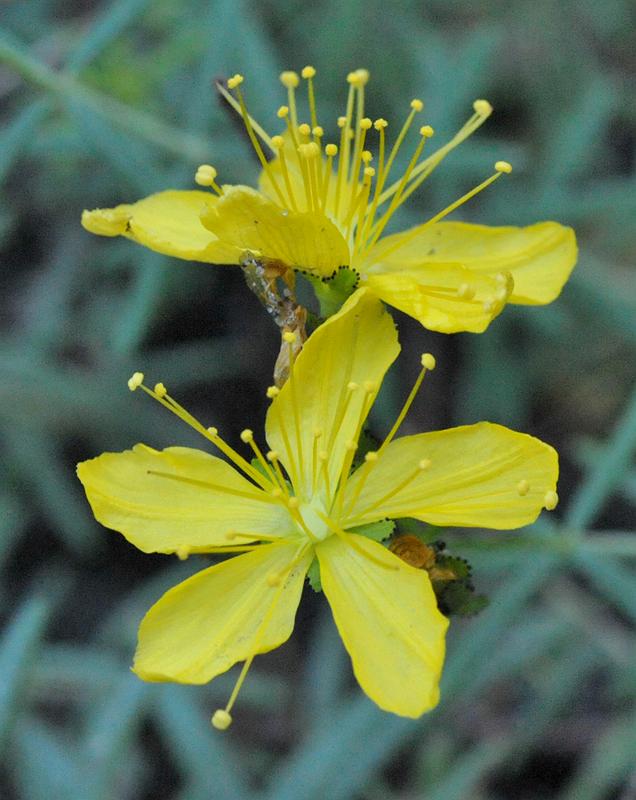

|
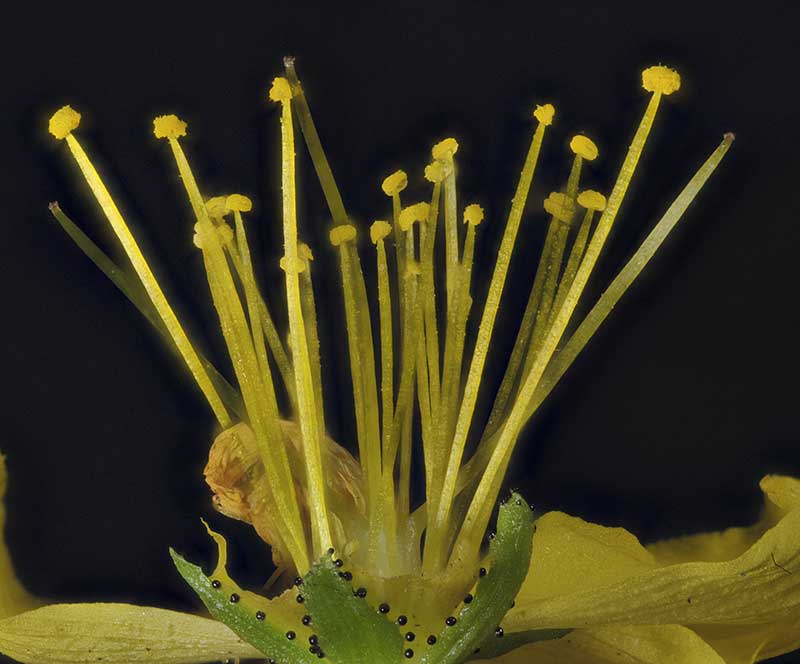

| |
| Iris schachtii is native to Anatolia, Turkey, and is widely cultivated elsewhere. |
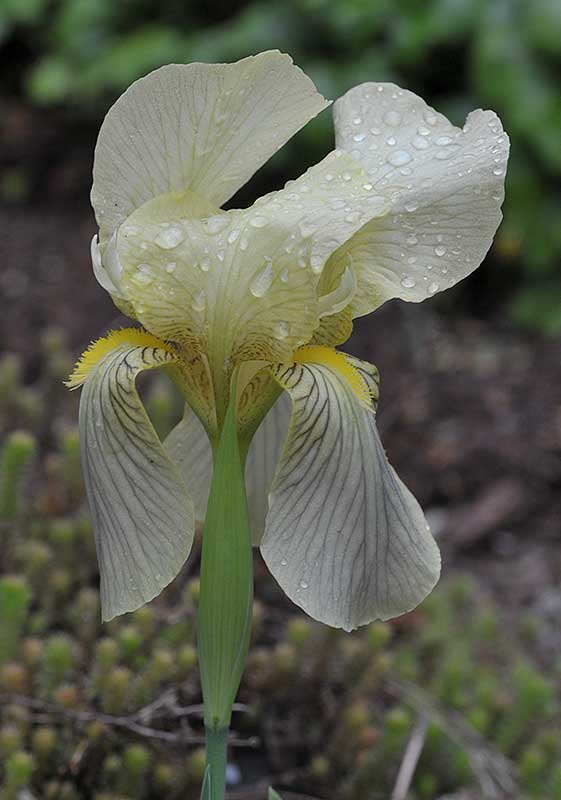

| ||
| Iris suaveolens flavescens is originally from rocky limestone hillsides of the Balkans, but this variety originates from Spain; it accepts full sun to part shade; flower height 65 mm. |
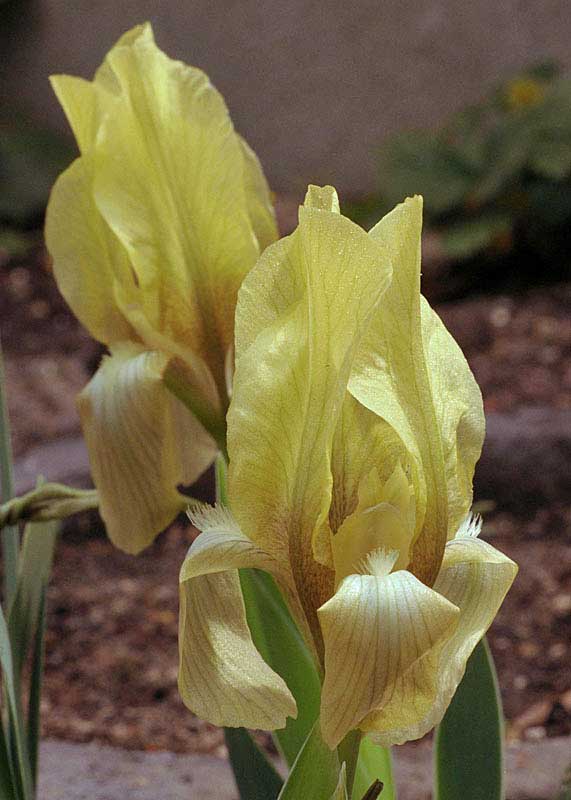

|
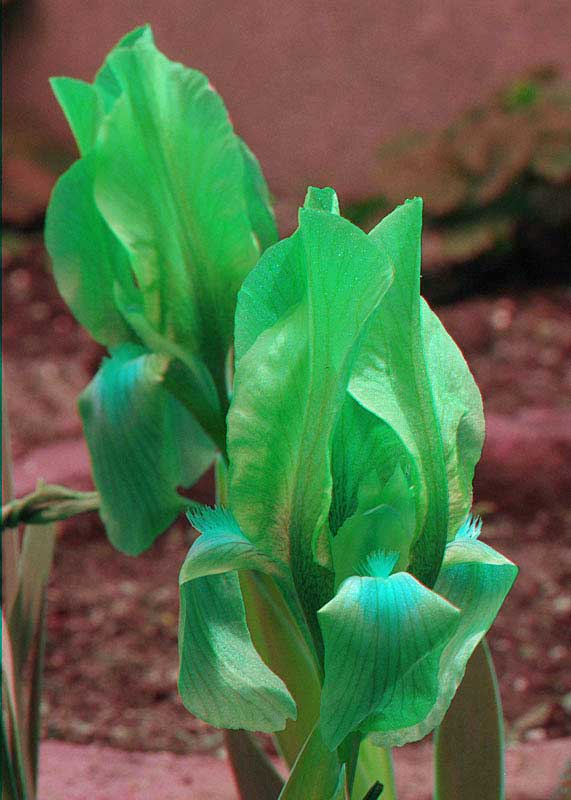

| |
| Potentilla crantzii is panarctic, usually in dry, favourable habitats like meadow slopes and the base of south-facing cliffs, mostly on near-neutral substrates; flower diameter 16 mm. |
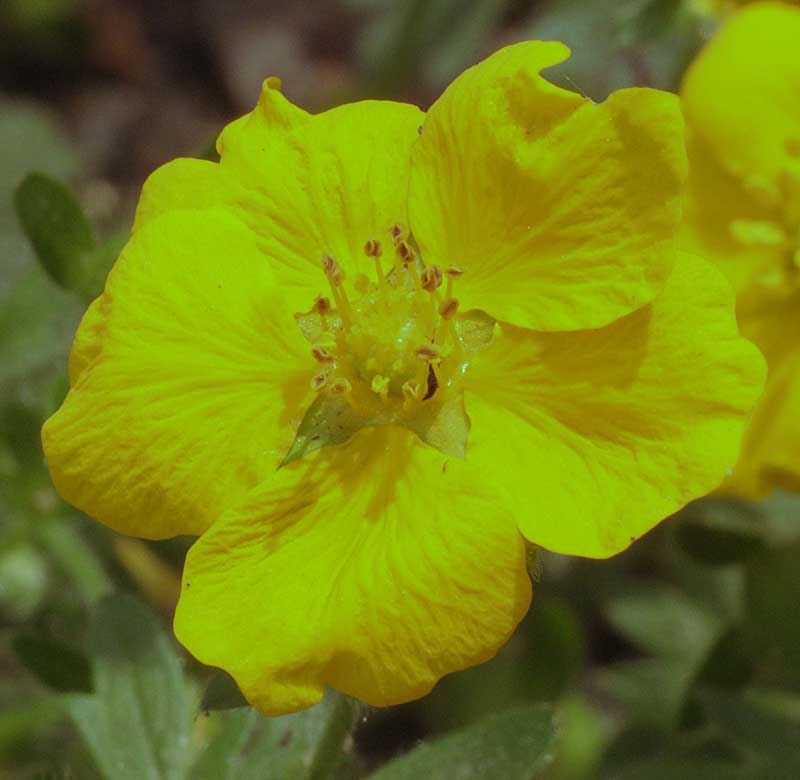

|
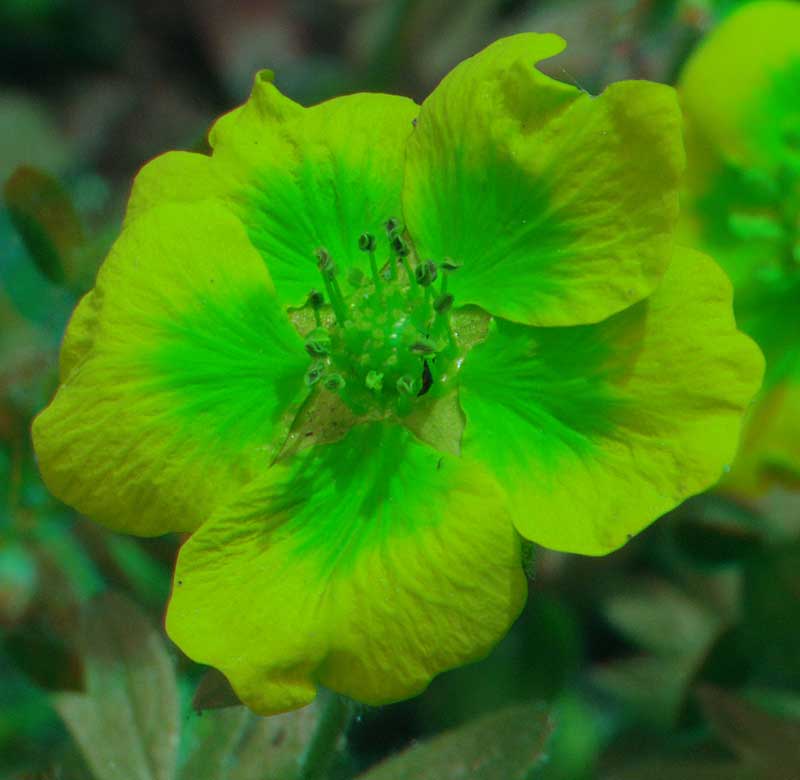

| |
| Potentilla uniflora is native to north-western North America; flower diameter 18 mm. |
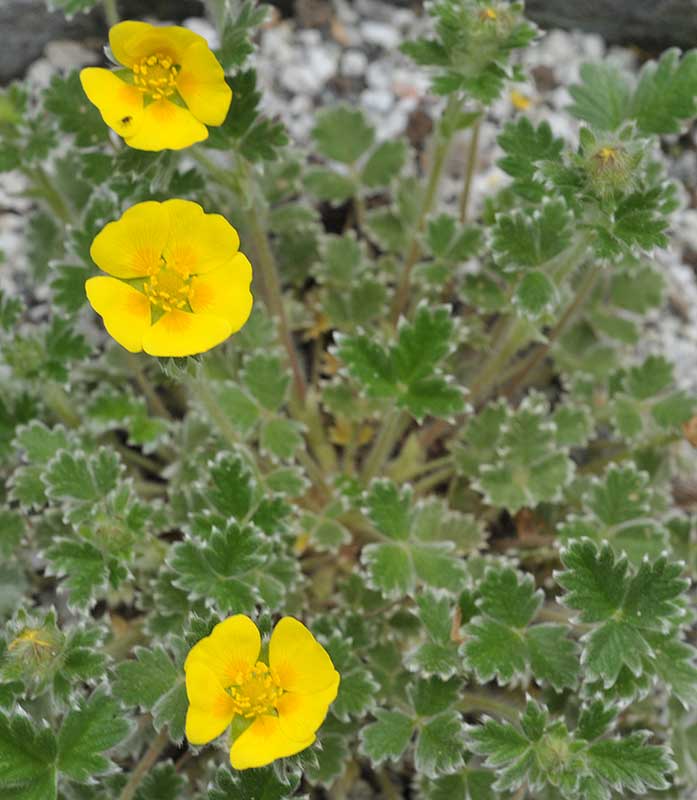

| ||
| Ranunculus acris, naturalized locally from damp permanent-pasture meadows of Europe, is doing well in 30% sun behind the pots. Its petal cells have two flat surfaces from which light is reflected. One is the top of the cells, the other exists because the epidermis is separated from the lower layers of the petal by an air gap. Reflection of light by the two surfaces combined doubles the gloss of the petal, which is why buttercups are such bright yellow; flower diameter 28 mm. |
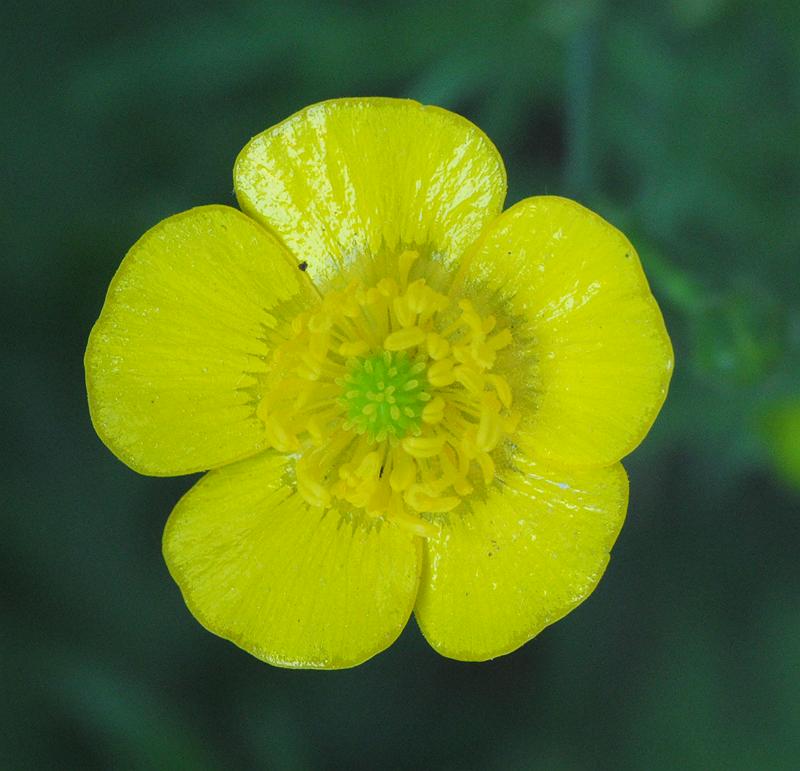

|
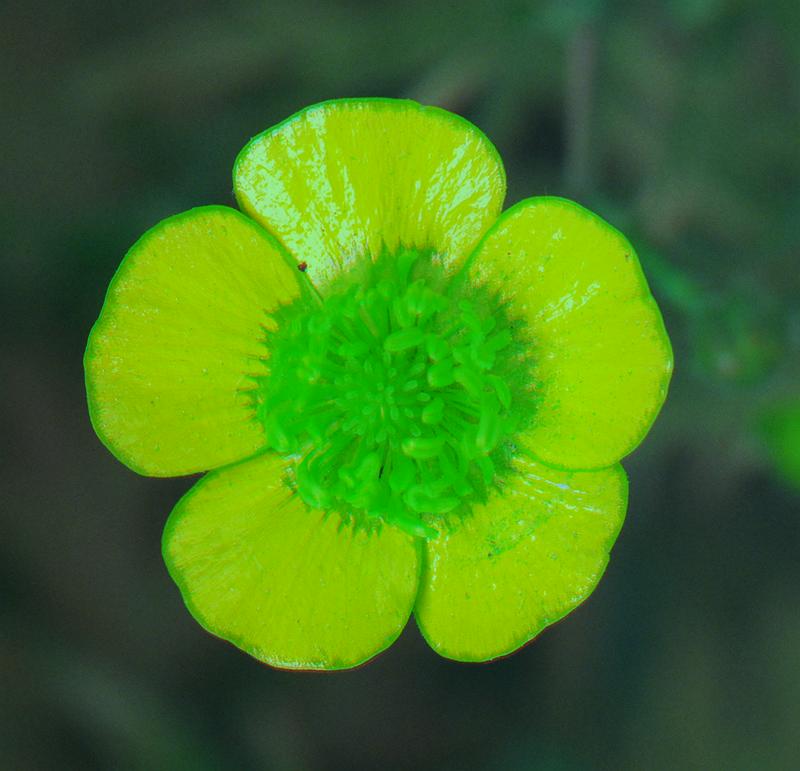

| |
| This Saxifraga was sold by Wrightman as 'Boston Spa' which has a white bloom with yellow center. |
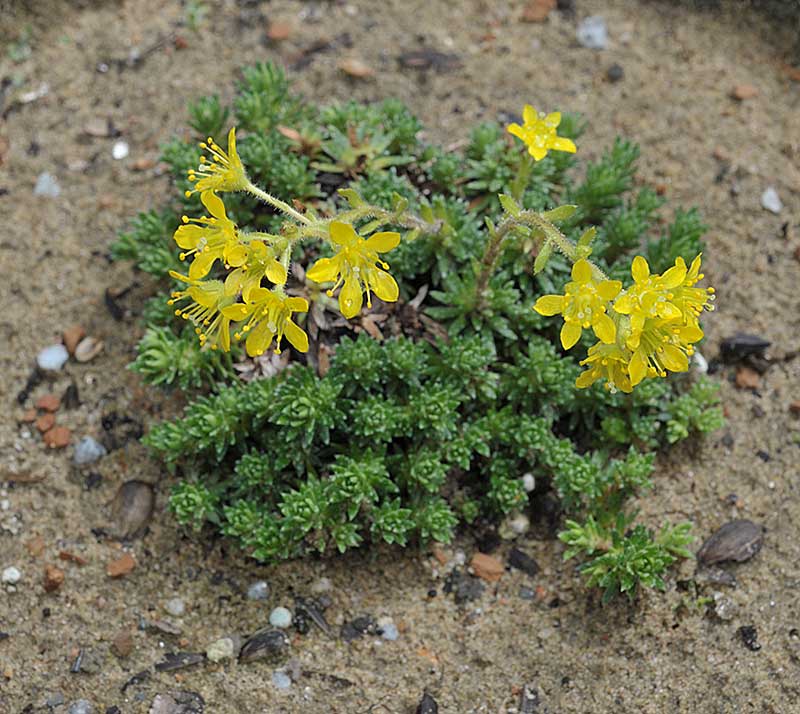

|
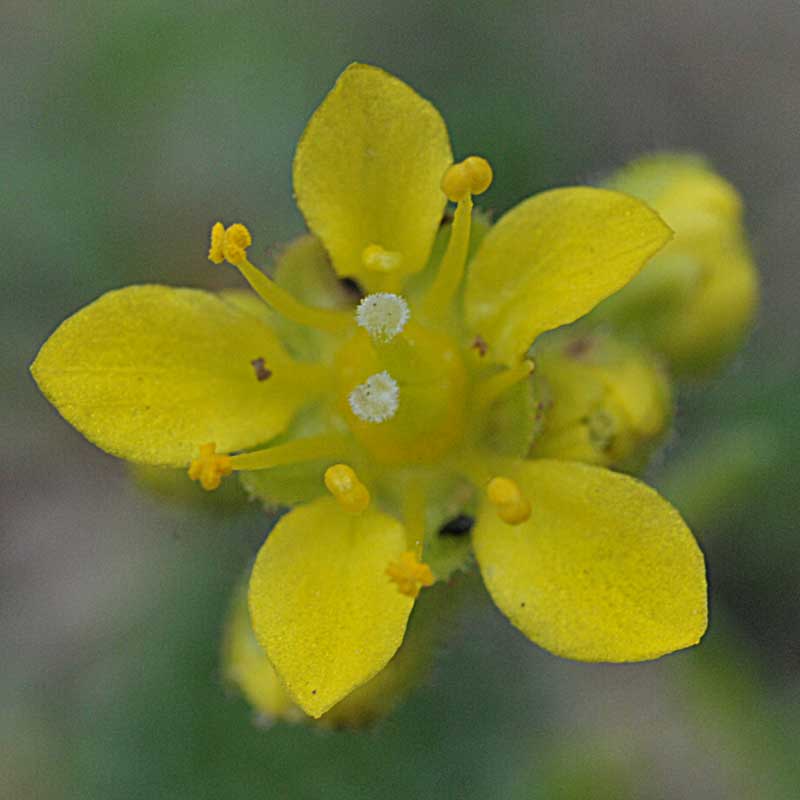

| |
| Saxifraga 'Elizabeth Sinclair' was introduced in 1967 by H.Lincoln Foster and is a cross between S.×elisabethae 'Sylva' and (probably) S.burseriana; flower diameter 10 mm. |
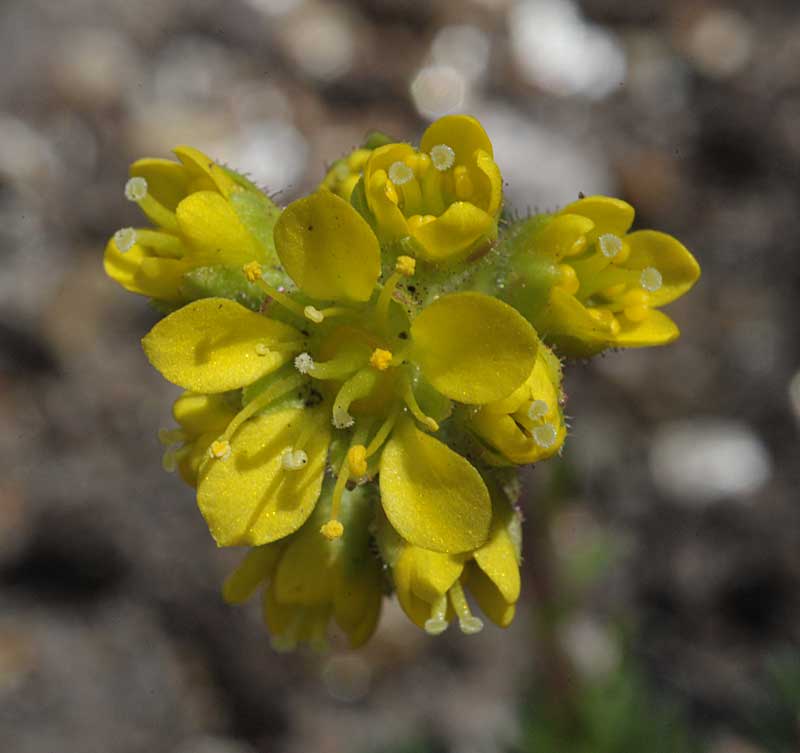

| ||
| Sedum sexangulare is native to Europe & Asia; flower diameter 8 mm. |
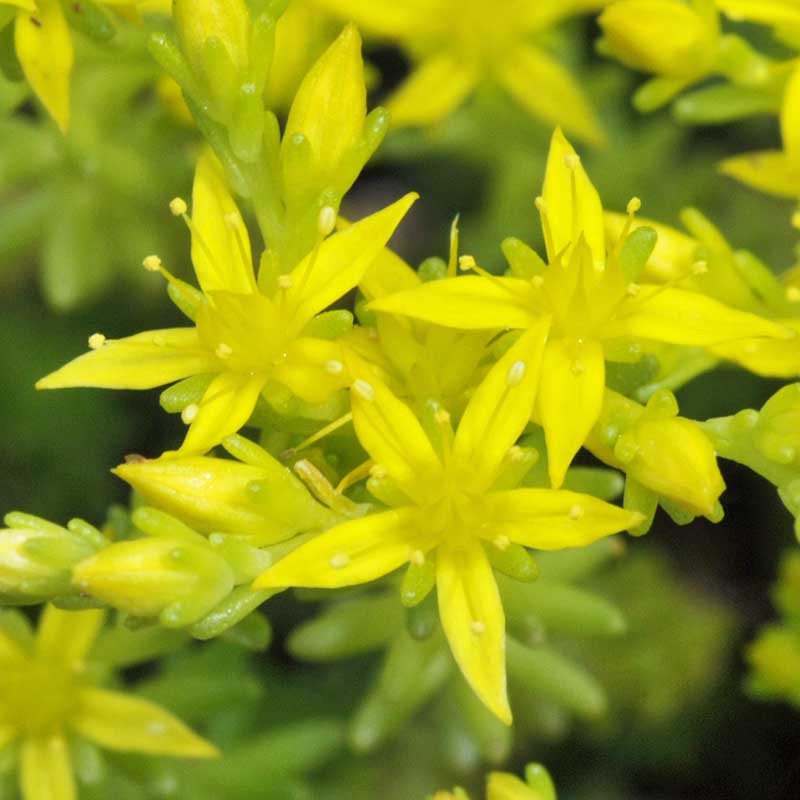

| ||
| Senecio pauperculus (Packera paupercula) is native locally on limestone soils; its ray florets are complete so can self-fertilize (the closeup is of a disc floret); composite diameter 15 mm. |
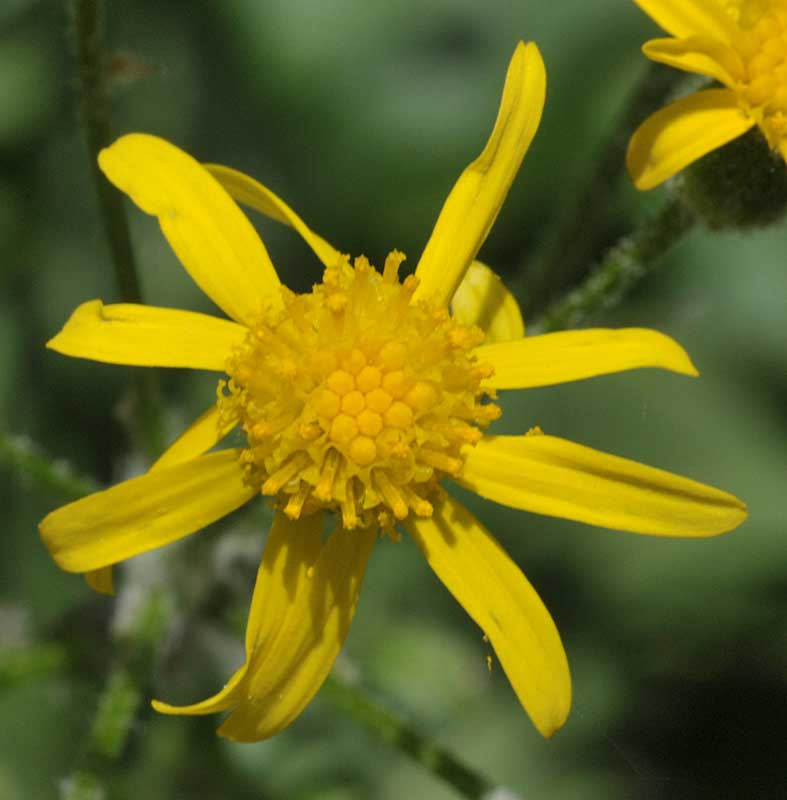

|
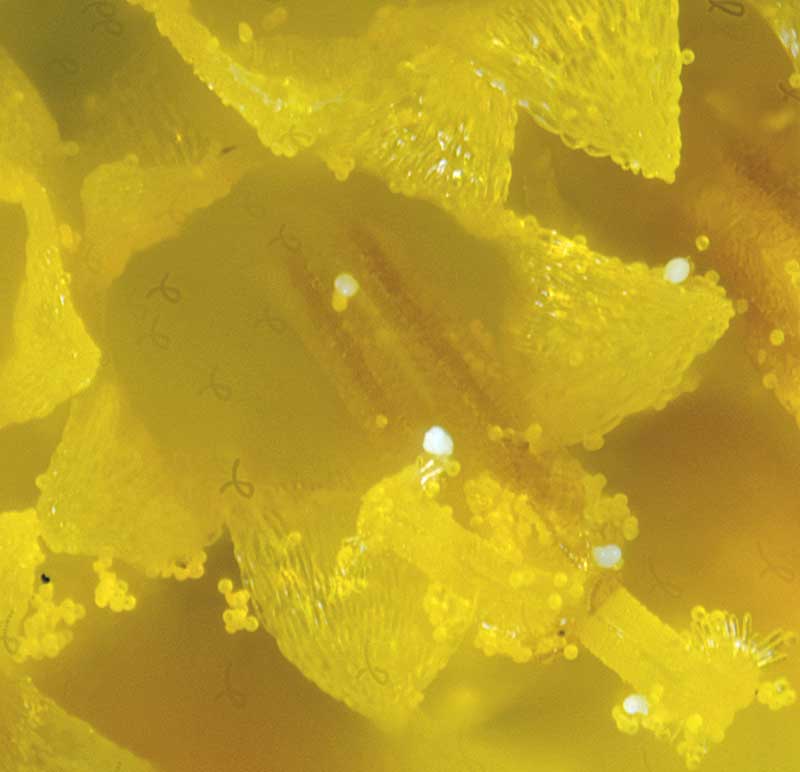

| |
| Solidago sphacelata is native to calcareous woods of eastern North America, selection Golden Fleece was added spring 2011 for trial after several years of trying to find it in Canada. (Even then, the nursery that agreed to special order it kept it hidden from customers until I picked it up!) It tried to bloom each year but its blooming stems rotted when exposed to my alkaline sprinkler water during dry spells. It was moved here, outside the sprinkler zone, 2016 and is doing much better. The last in bloom of my Solidago. |
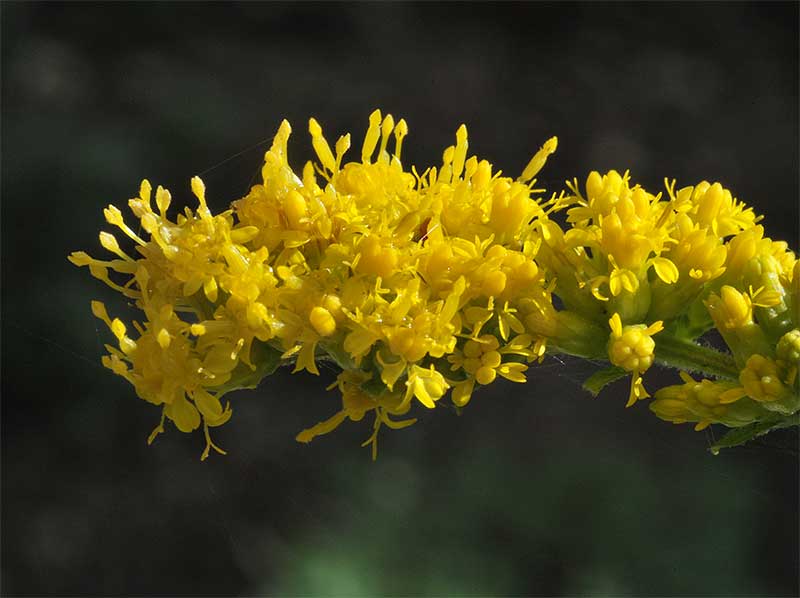

|
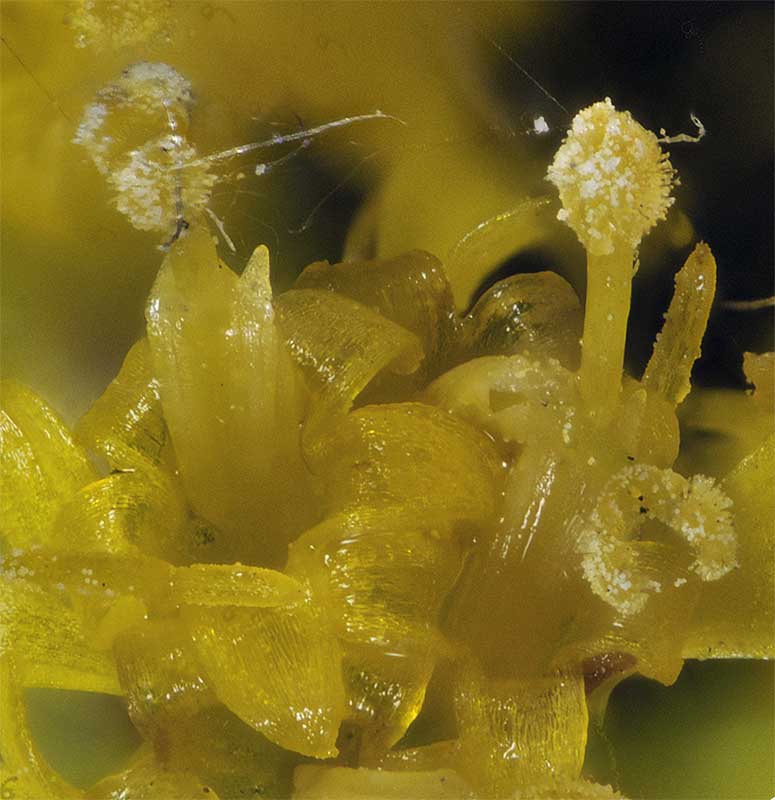

| |
| Waldsteinia ternata is native to central Europe and is on trial as a ground cover behind the pots; it's not doing well. It looks so similar to Ranunculus repens that I suspect a splitter at work rather than botany; flower diameter 22 mm. |
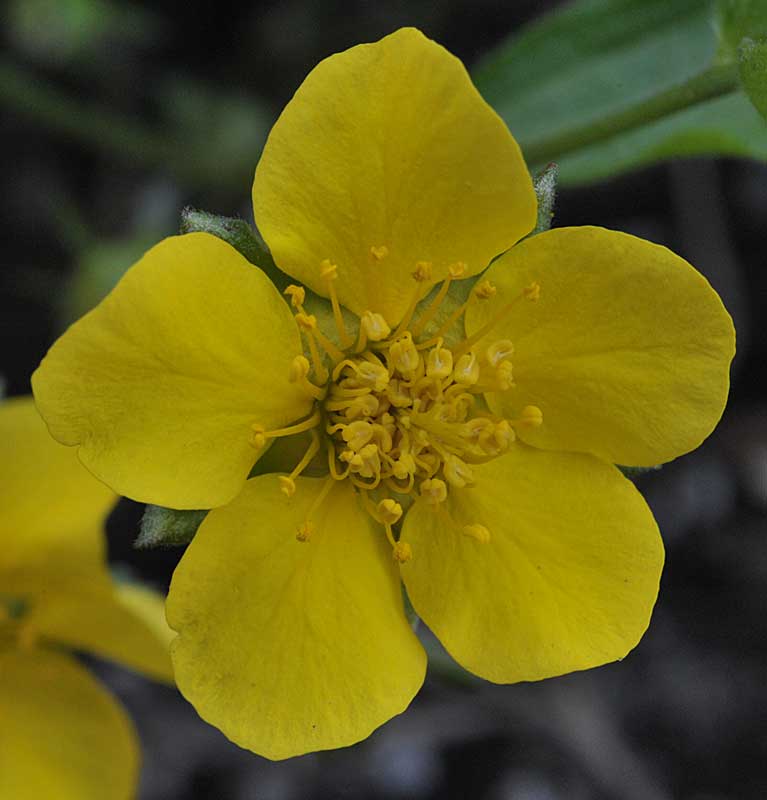

|
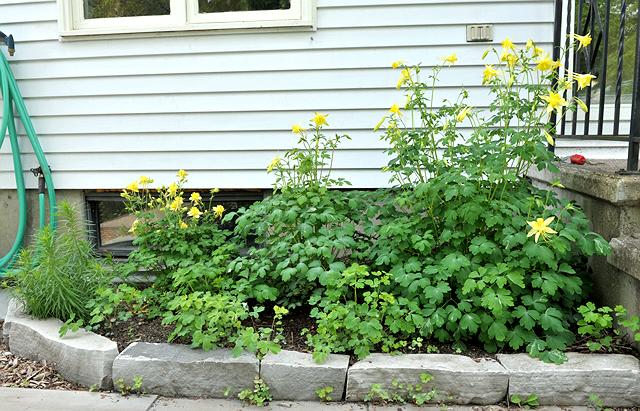
| This was built fall 2011 primarily for the beautiful yellow Aquilegia that strongly prefer a pH on the acid side. | mouseover thumbnails for full images
human insect |
| Aquilegia chrysantha, native to mountainous southern USA, is a medium-life perennial that I allow to set seed in order to maintain itself; hybrids (doubles etc.) can only be treated as annuals since they don't reproduce true by seed. It's mostly pollinated by spectacular Sphinx hawkmoths, 7 species of which are recorded in Ontario; flower diameter 40 mm; 20% sun. |
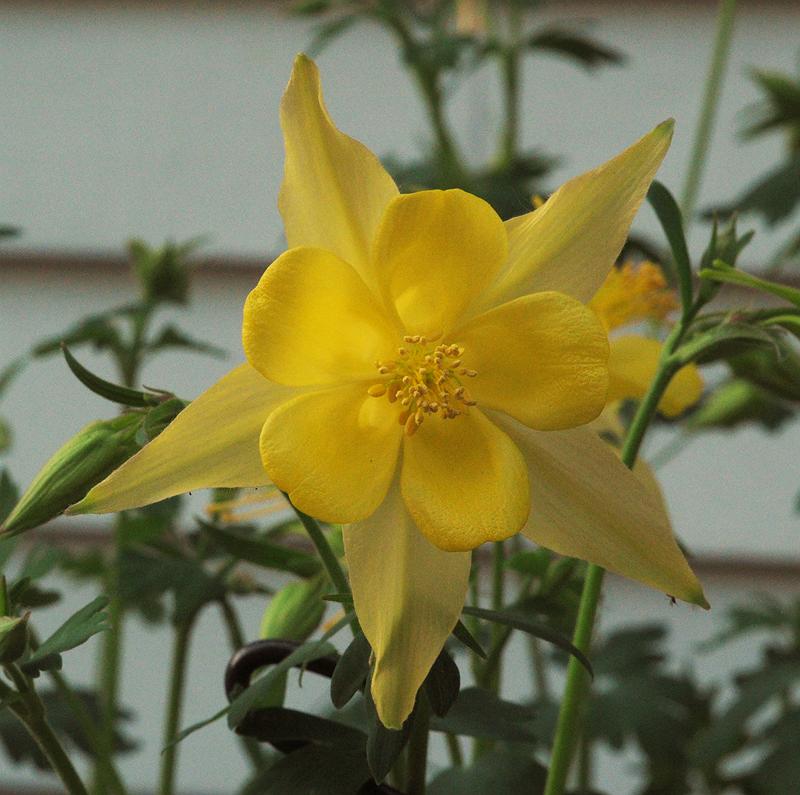

|
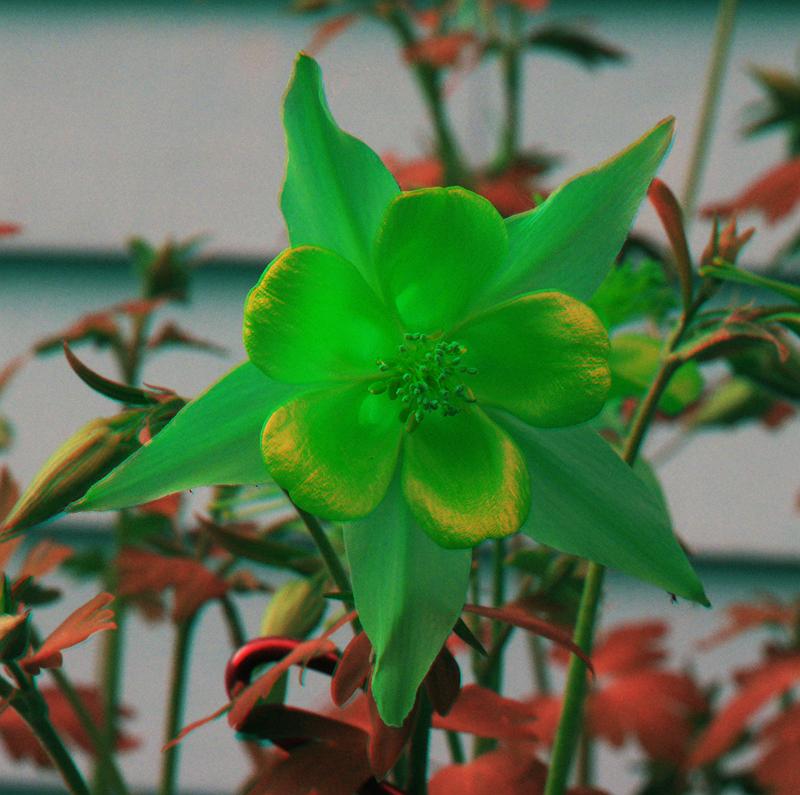

| |
| Linaria vulgaris, colloquially butter&eggs, native to Europe and northern Asia and naturalized locally, was added fall 2011. It grows 20 cm high along road edges where it's usually seen, but is reaching half a meter high here; it spreads too fast for most gardens; 20 mm flower size; 30% sun. |
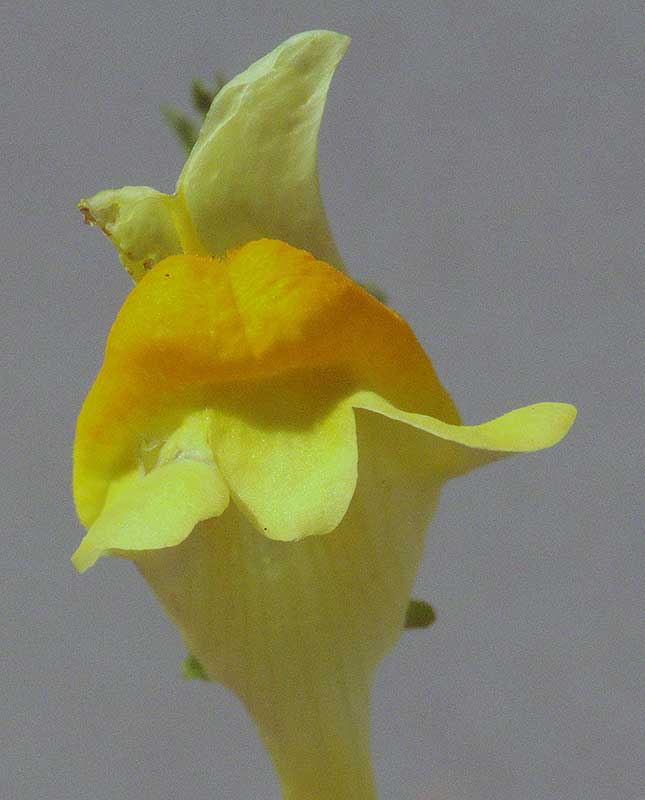

|
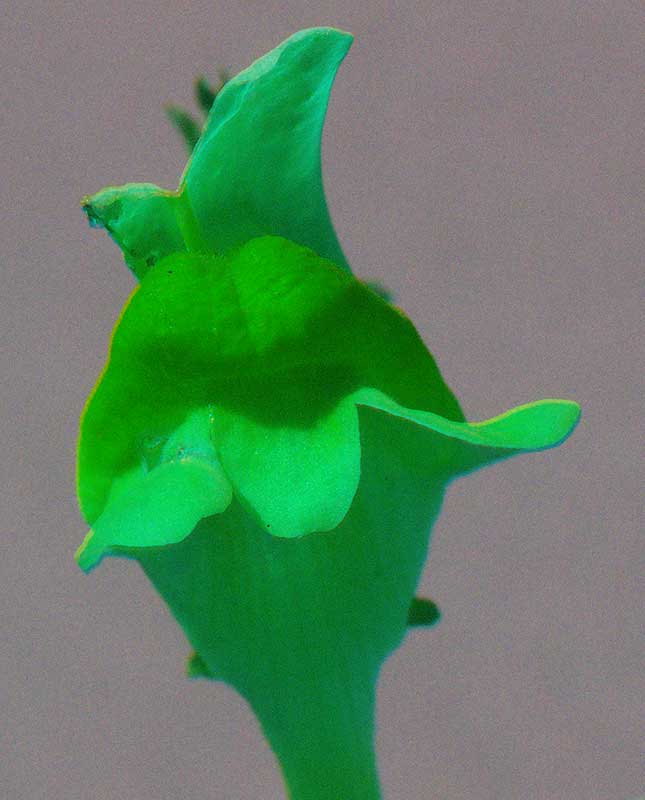

|
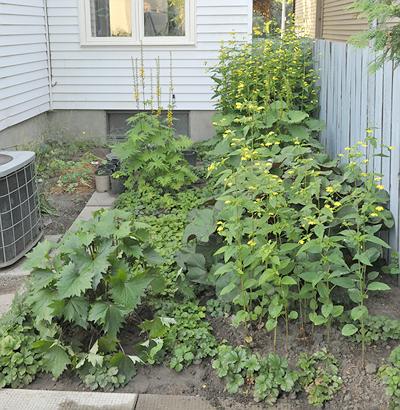
| This area was built summer 2008 with 10% added sand in the top 20 cm to let more air into the soil. | mouseover thumbnails for full images
human insect |
| Corydalis lutea is native to moist woodlands of the southern foothills of the European Alps and grows in heavy to light shade. It's a short-lived perennial that self-maintains through seeding and prefers slightly alkaline soils. |
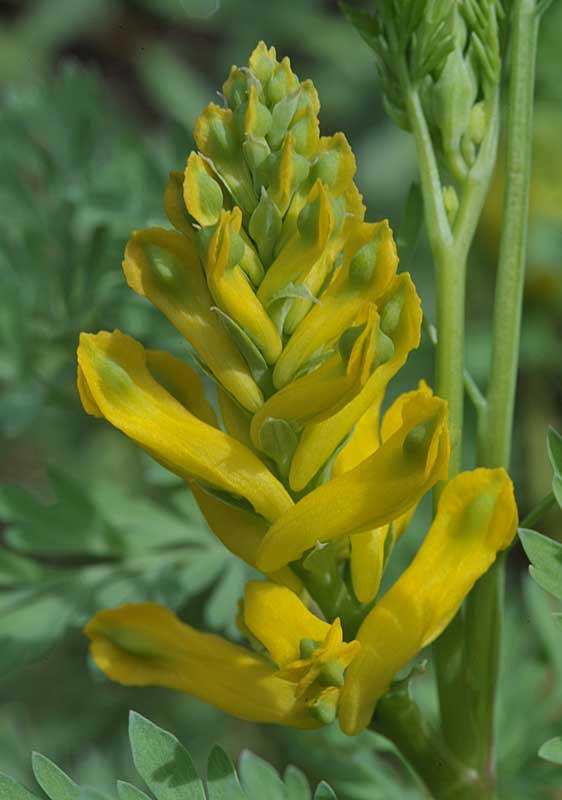

|
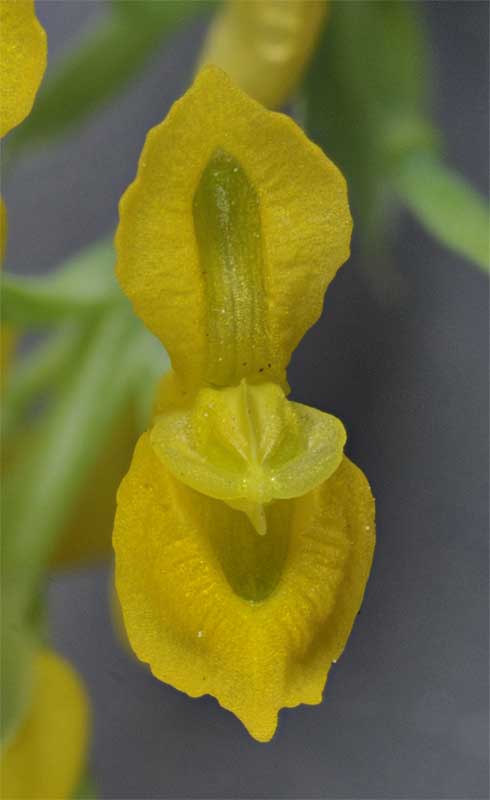

| |
| Epimedium 'Amber Queen' was added spring 2014 |
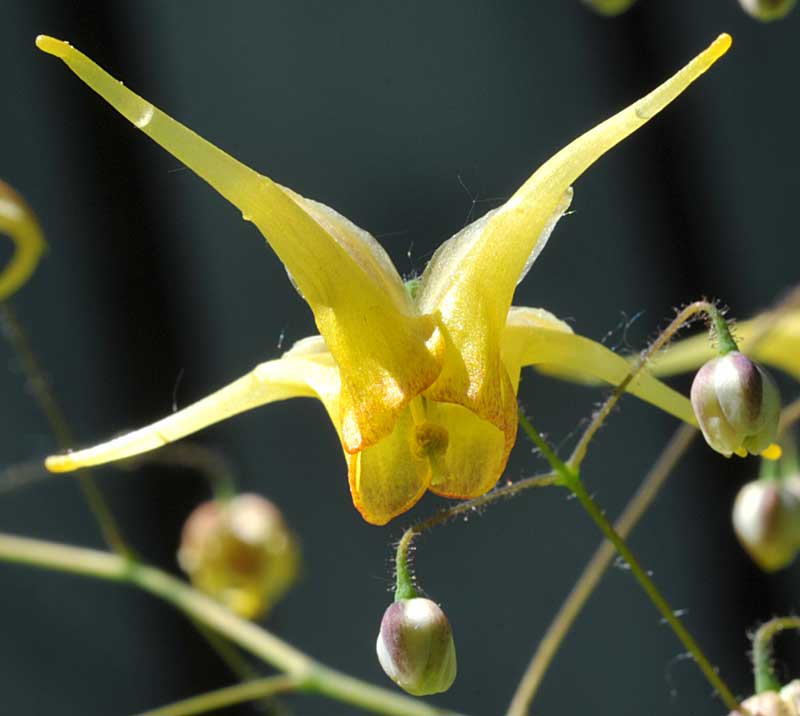

|
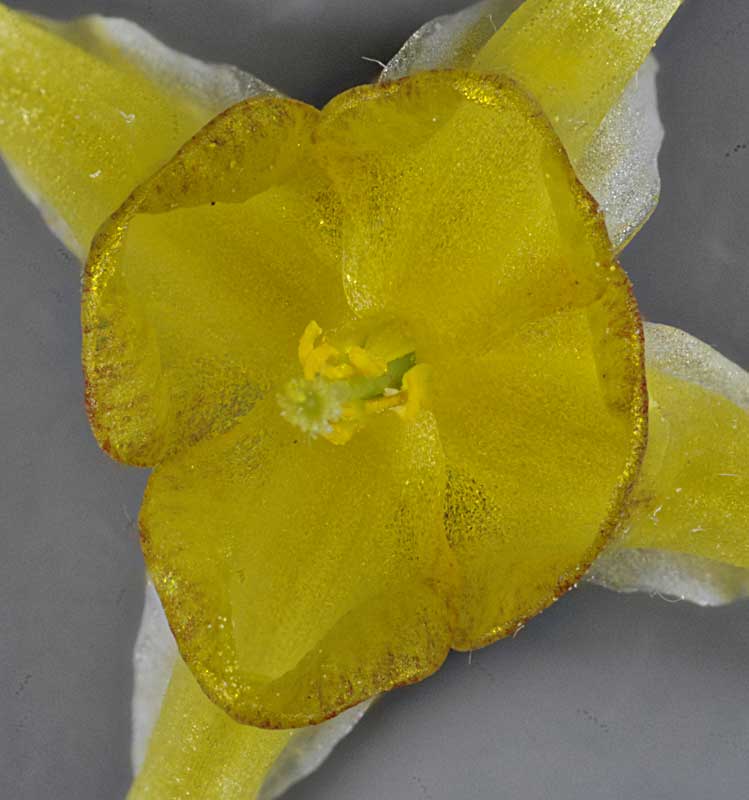

| |
| Ligularia's tropical-sized foliage fills this space with luxuriant growth:
Ligularia dentata, native to eastern China, is a large plant, forming a mound 2 m wide and 1 m high with large irregular flower clusters in September, later than any other Ligularia. Reliable, but untidy blooms compared to other Ligularia; 20% sun. |
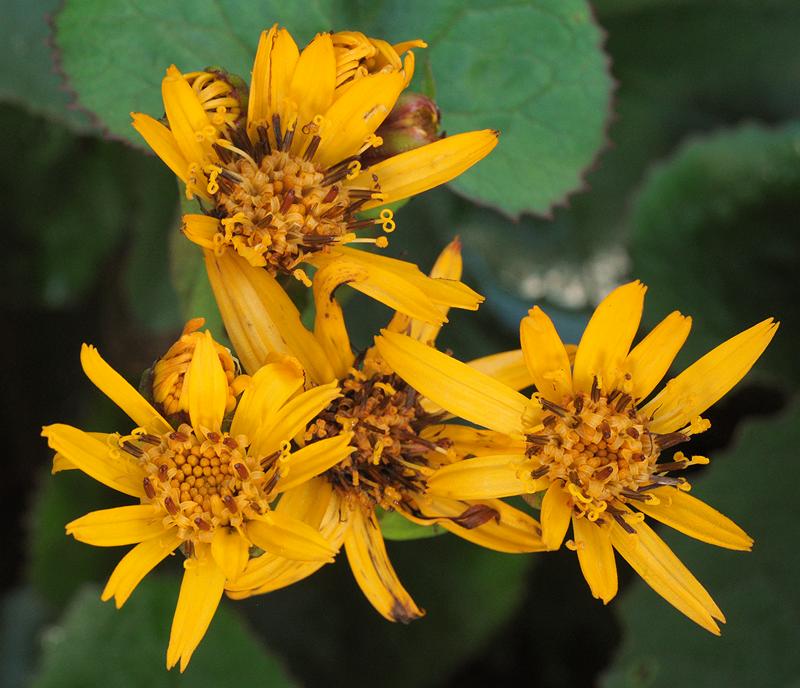

|
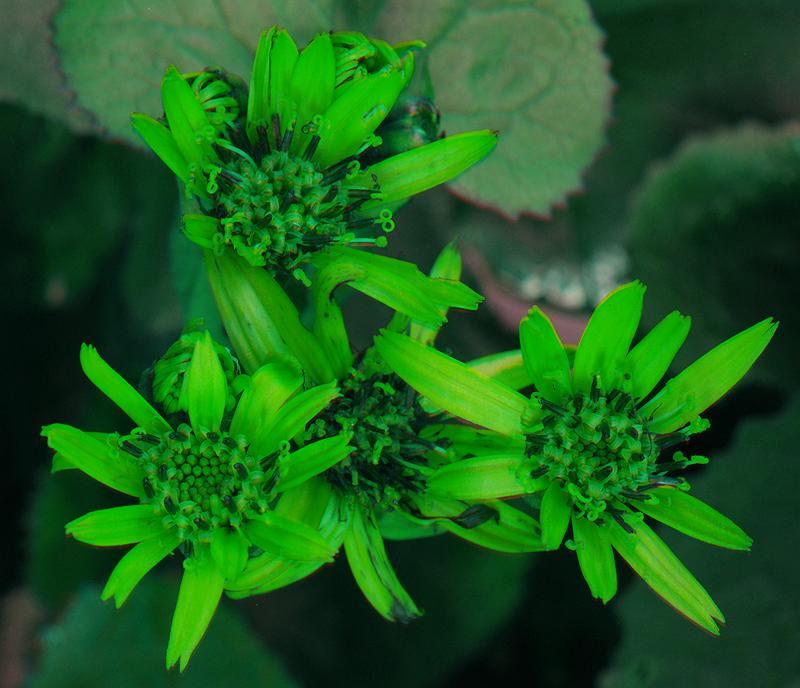

| |
| Ligularia'Little Rocket' is doing well, its jet black stems really stand out and it has beautifully curved anthers; 40 mm diameter; 30% sun. |
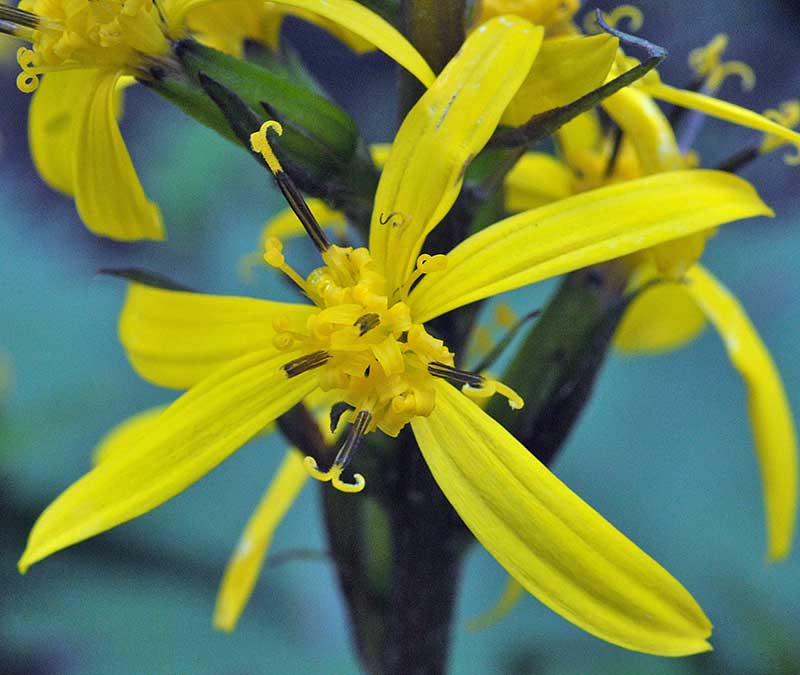

|
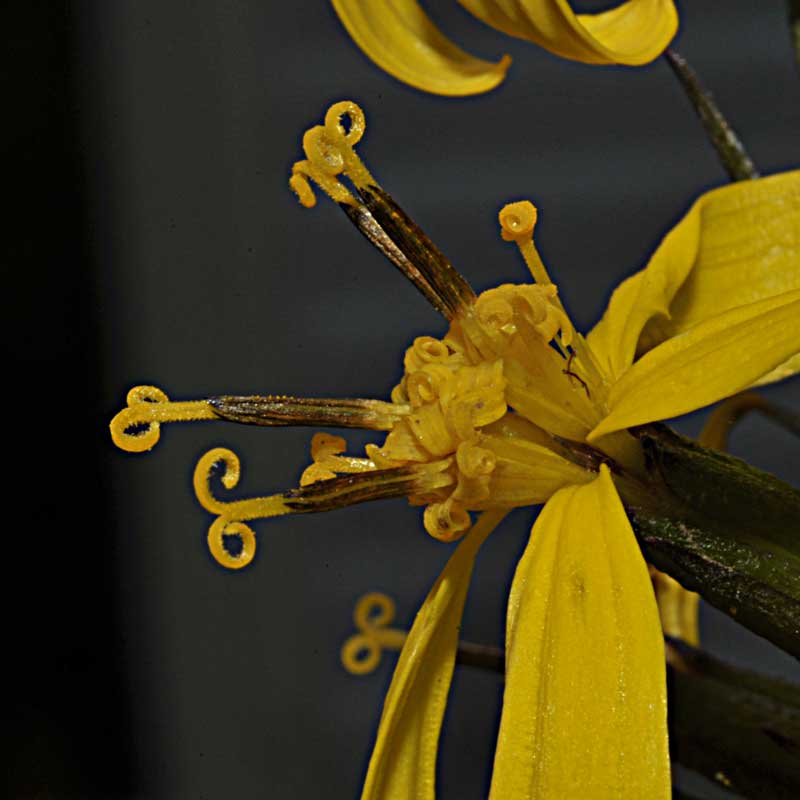

| |
| Ligularia przewalskii from SE Asia is intolerant of direct sun or heat, the leaves droop alarmingly within an hour even with moist soil, but it doesn't seem to affect its health. Its flowers are rather sparse; 25 mm diameter; 20% sun. |
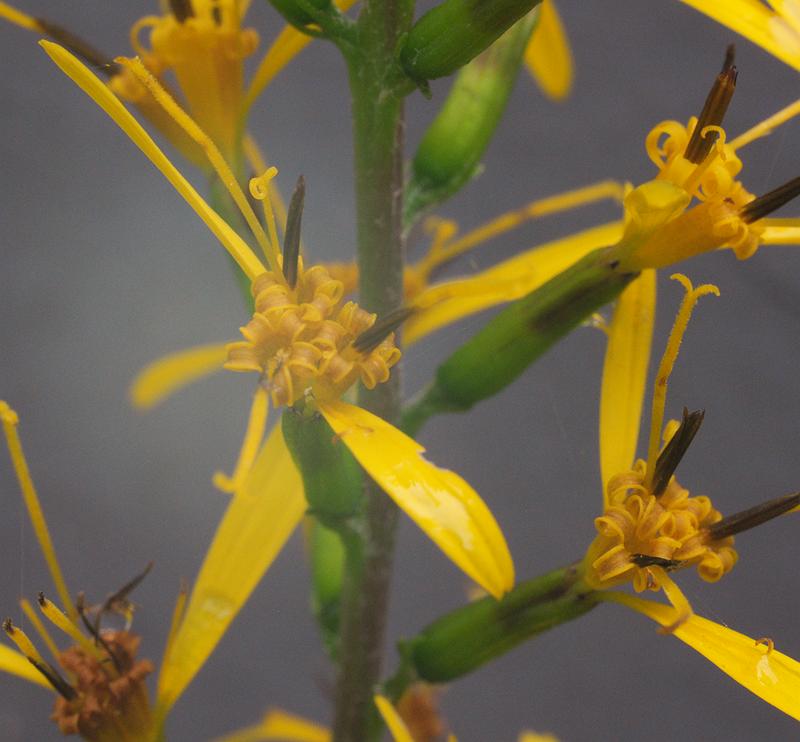

|
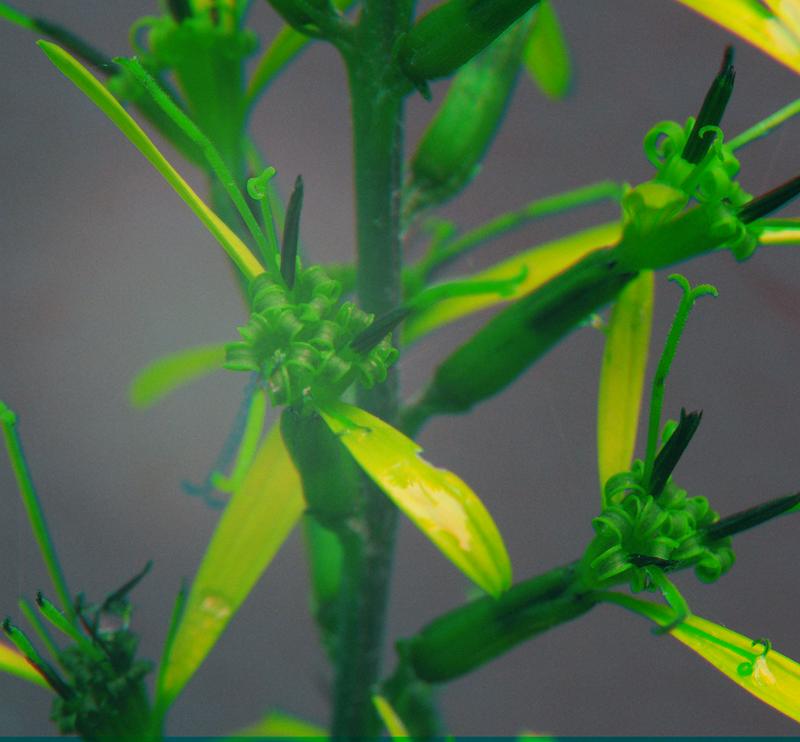

| |
| Ligularia stenocephala (Senecio stenocephalus) from SE Asia has numerous spectacular tall flower spikes, my favourite Ligularia; 20% sun. |
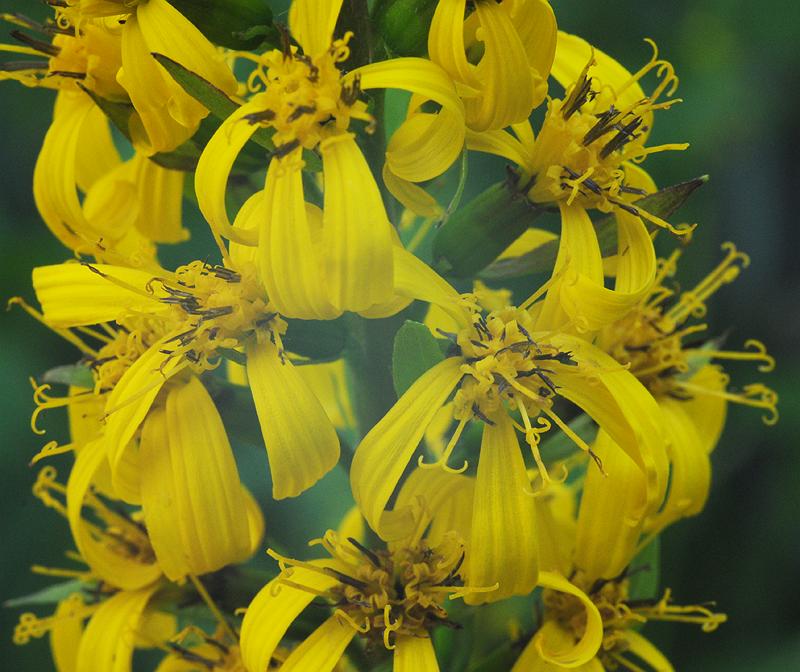

|
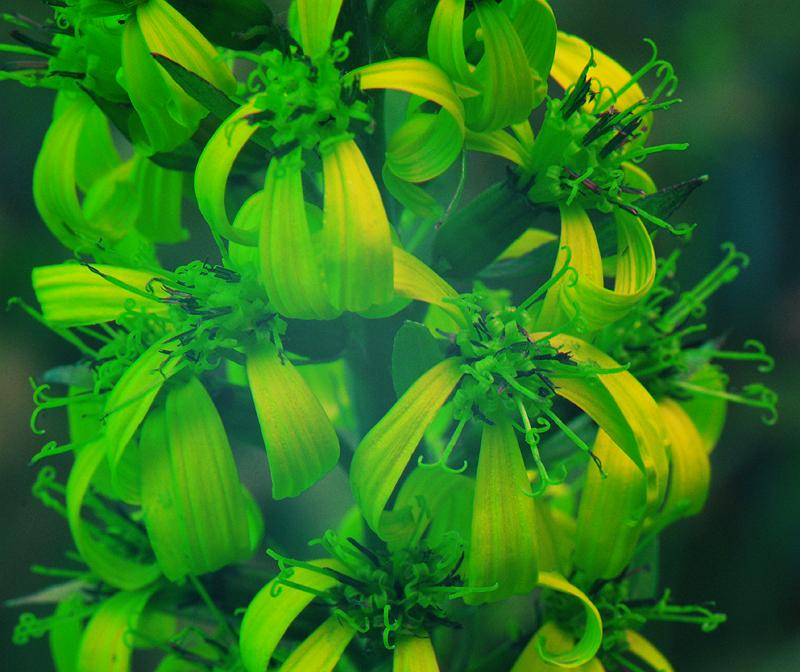

| |
| Lysimachia quadrifolia, native locally, spreads too vigorously by underground runners for most gardeners; it has to be boxed in by deep edging (20 cm or more) to keep it under control. Its delicate-looking down-facing blooms last almost a month. The genus name honours Lysimachus, a general under Alexander who myth credits with using a plant shaped like a spear to pacify a maddened bull. It's true that the European Lysimachia vulgaris repels gnats and flies which upset cattle, however bull horns were the symbol of the sea-god Poseidon and the power to calm seas would have been attributed to any conqueror in the Mediterranean. The modern result of the myth is that any plant with a tall spike of flowers is liable to be called loosestrife in English. Yellow Loosestrife (Lysimachia order Ericales) is totally unrelated to the non-native Purple Loosestrife (Lythrum order Myrtales); flower diameter 30 mm; 20% sun. |
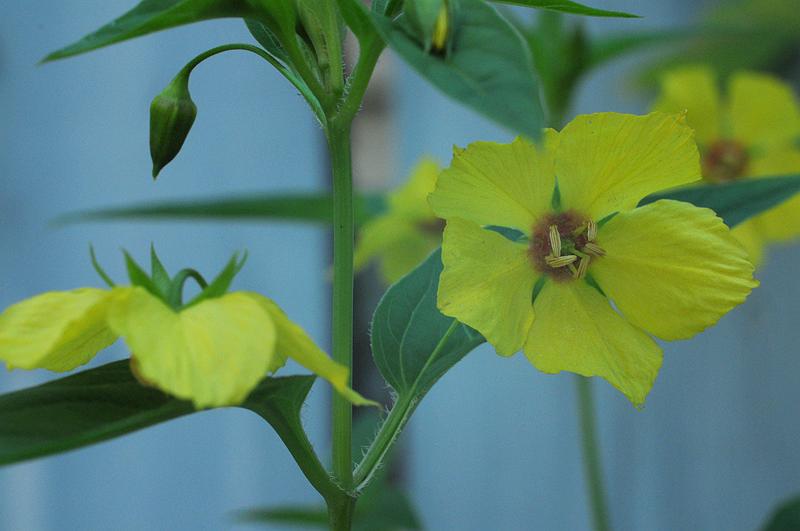

|
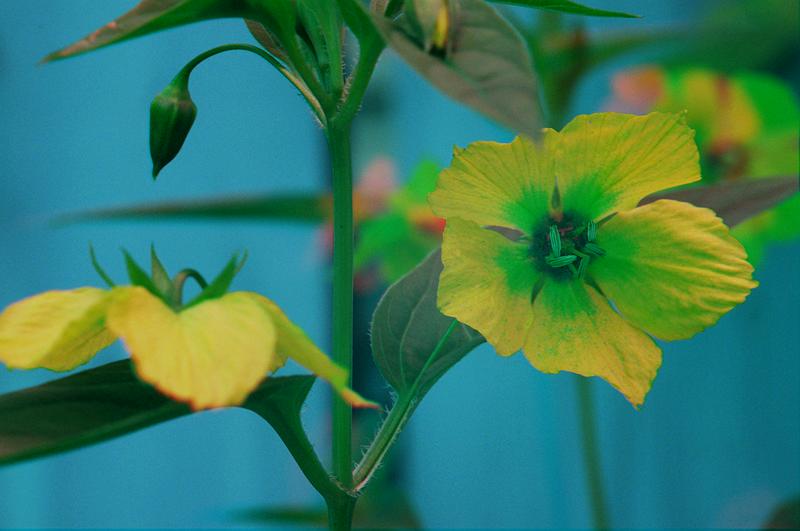

| |
| Parthenocissus tricuspidata 'Veitchii' is a small-leaved strain that's the only one sold by Ottawa garden centers. It tends to be killed back to the roots every decade or so in Ottawa; 30% sun. | |||
| Ranunculus repens from Europe is the ground cover here - a carpet of yellow blooms in spring and of green throughout the year. It's too vigorous a grower for small plants, but is an excellent match for Ligularia; flower diameter 15 mm; 10-30% sun. |
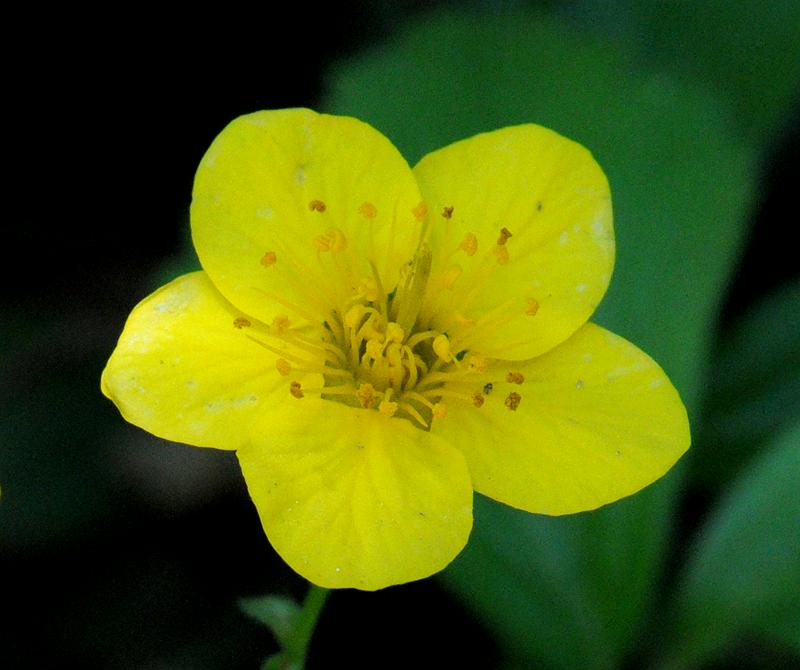

|
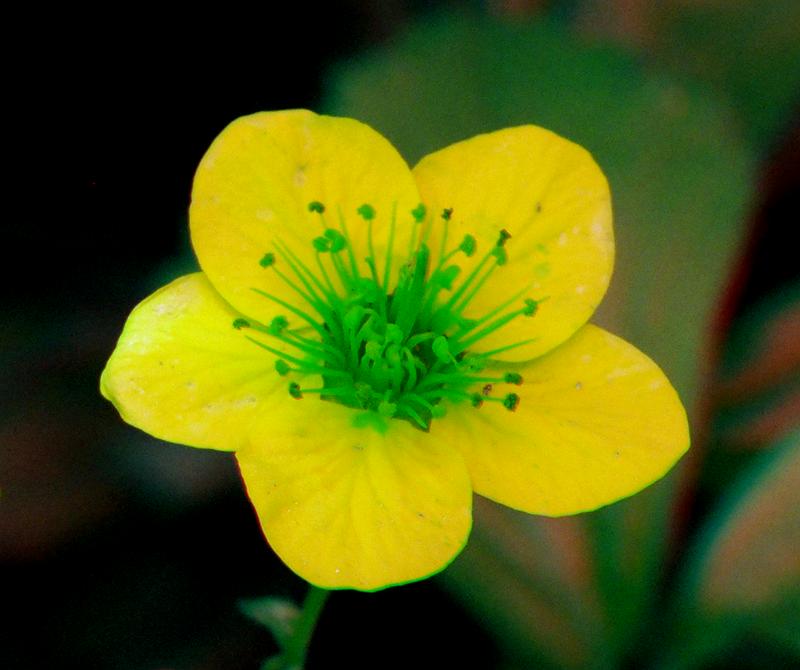

| |
| Solidago caesia with its bluish stems and axillary flowers is native locally in semi shade; mine attracts mostly Diptera as pollinators; it's the last to start blooming here, but S.sphacelata outlasts it; 30% sun. |
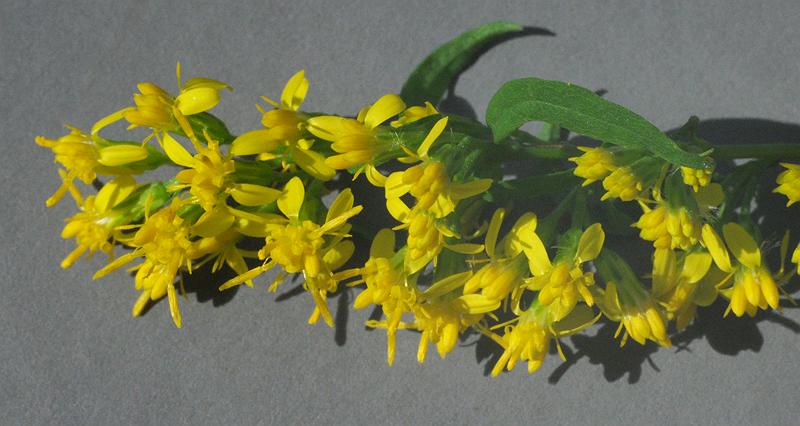

|
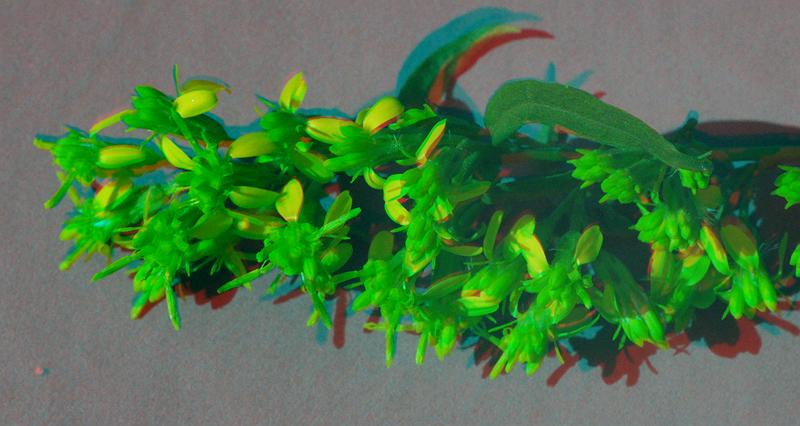

|
